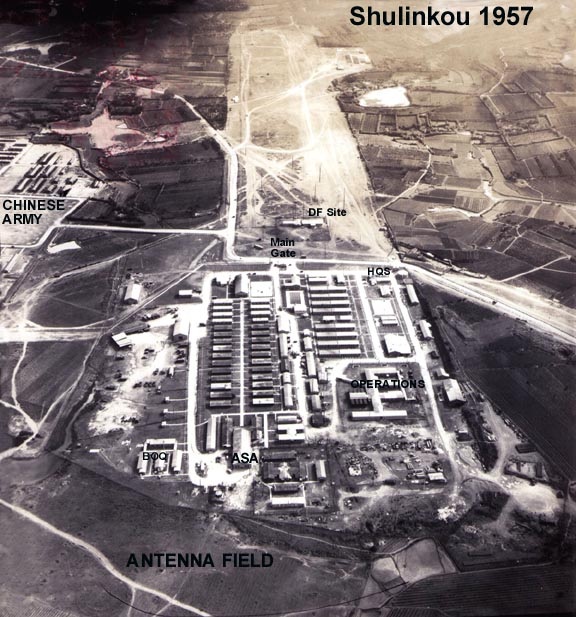
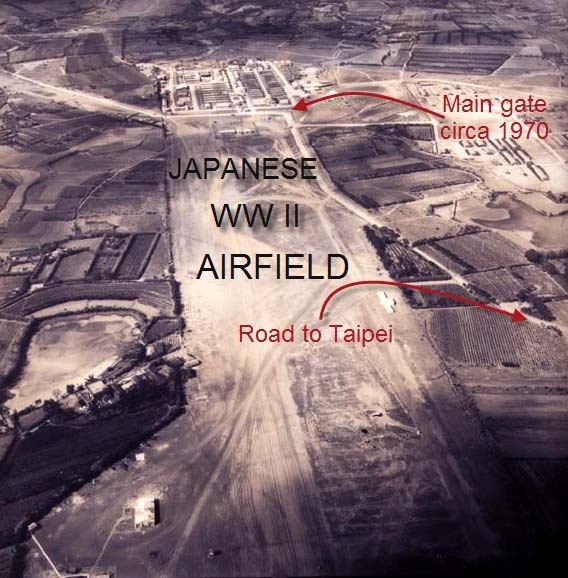
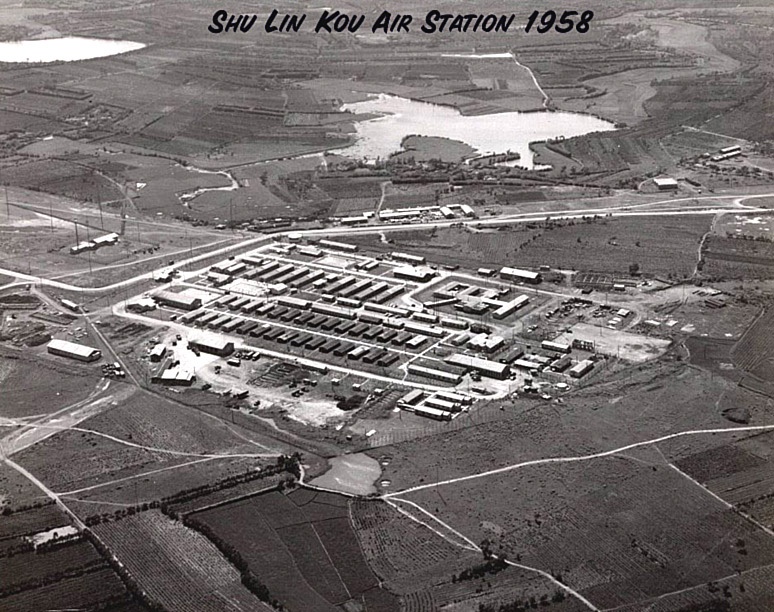
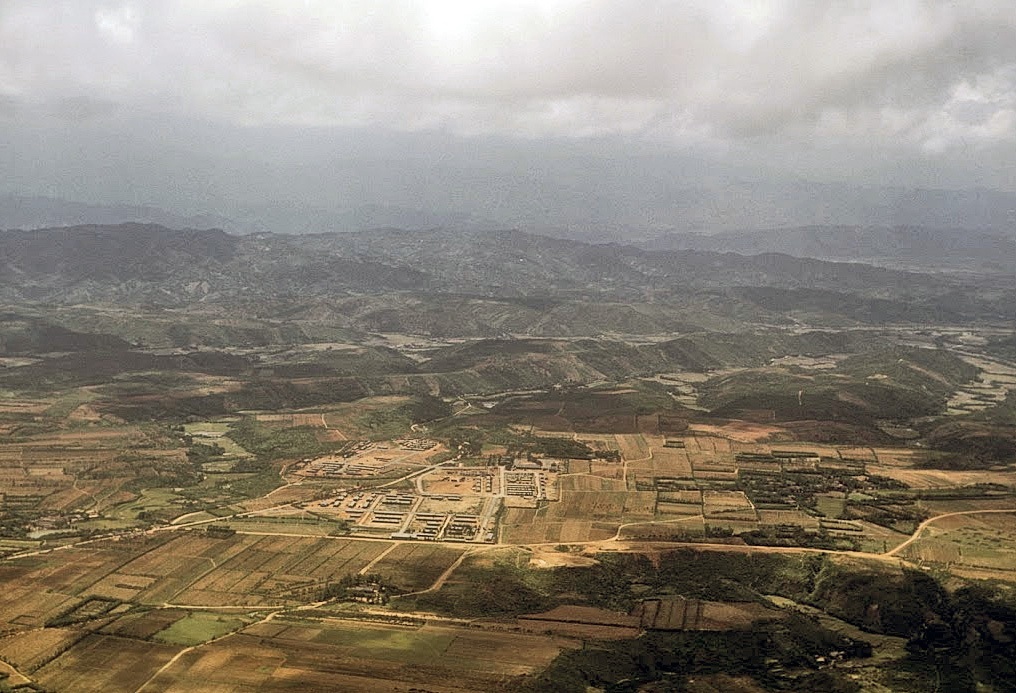

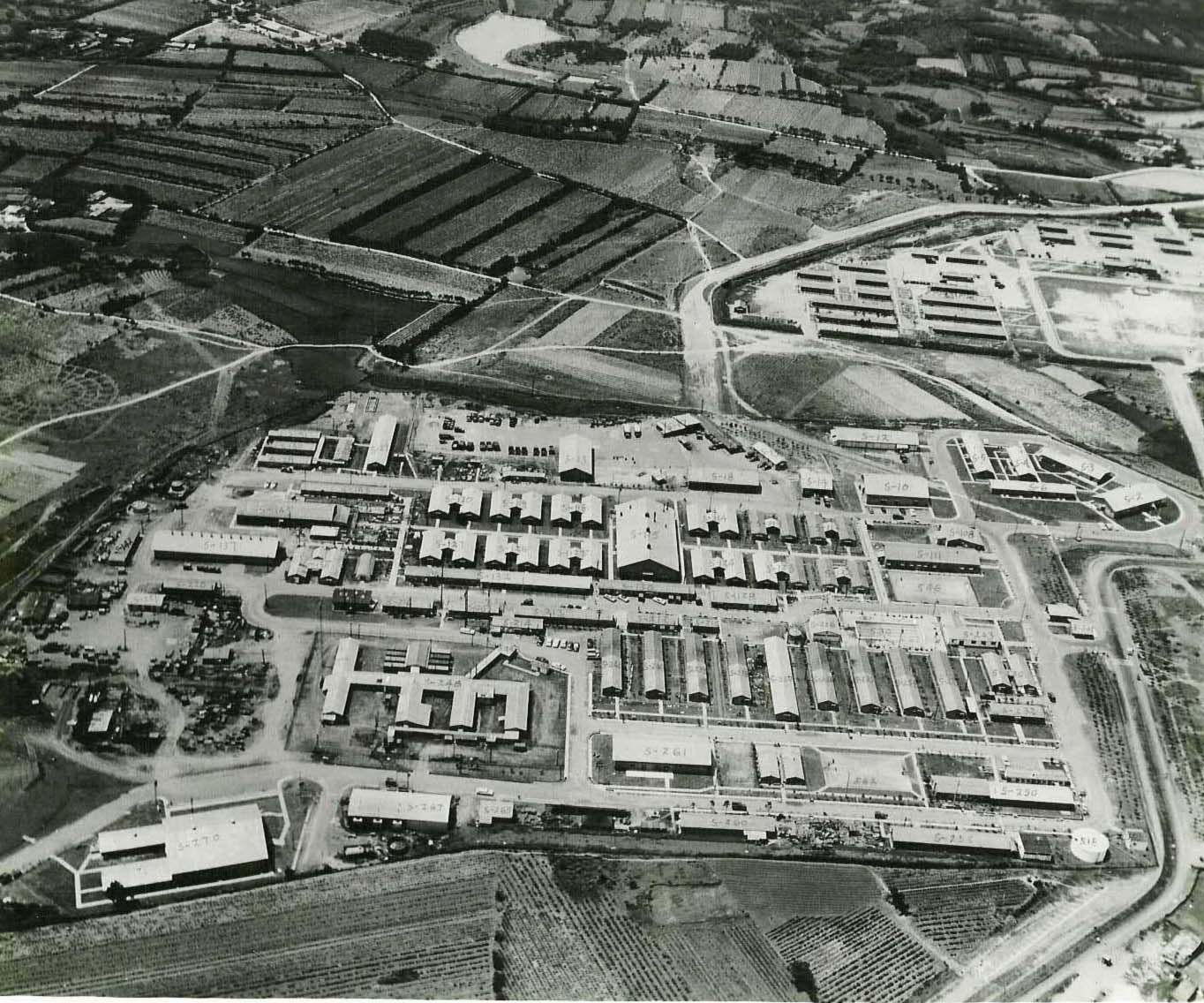






(1. & 2.) Shown in the two 1957 aerial photos (opposite views) above are remnants of the WWII Japanese Army airfield ("Lamsepo Airdrome") located beyond the "DF Site".
(3.) 1958 aerial photo showing the old sheet-metal Operations Building, open-bay barracks, and construction (far left) starting on the new Main Gate, Headquarters, and BOQ.
(4.) 1957/58 aerial photo showing Shulinkou Air Station and surrounding area.
(5. & 6.) Two identical July 12, 1960 aerial photos (photo 5. is annotated) of Linkou showing both Main Gates (far right of photos).

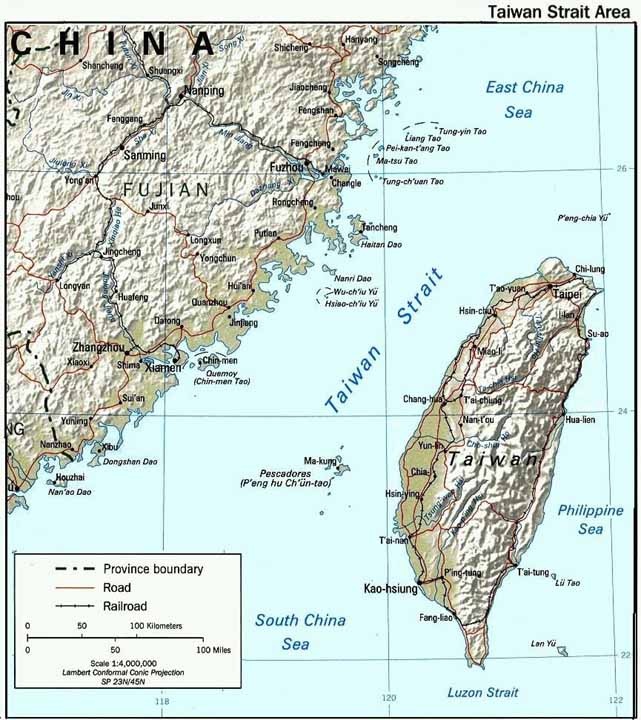
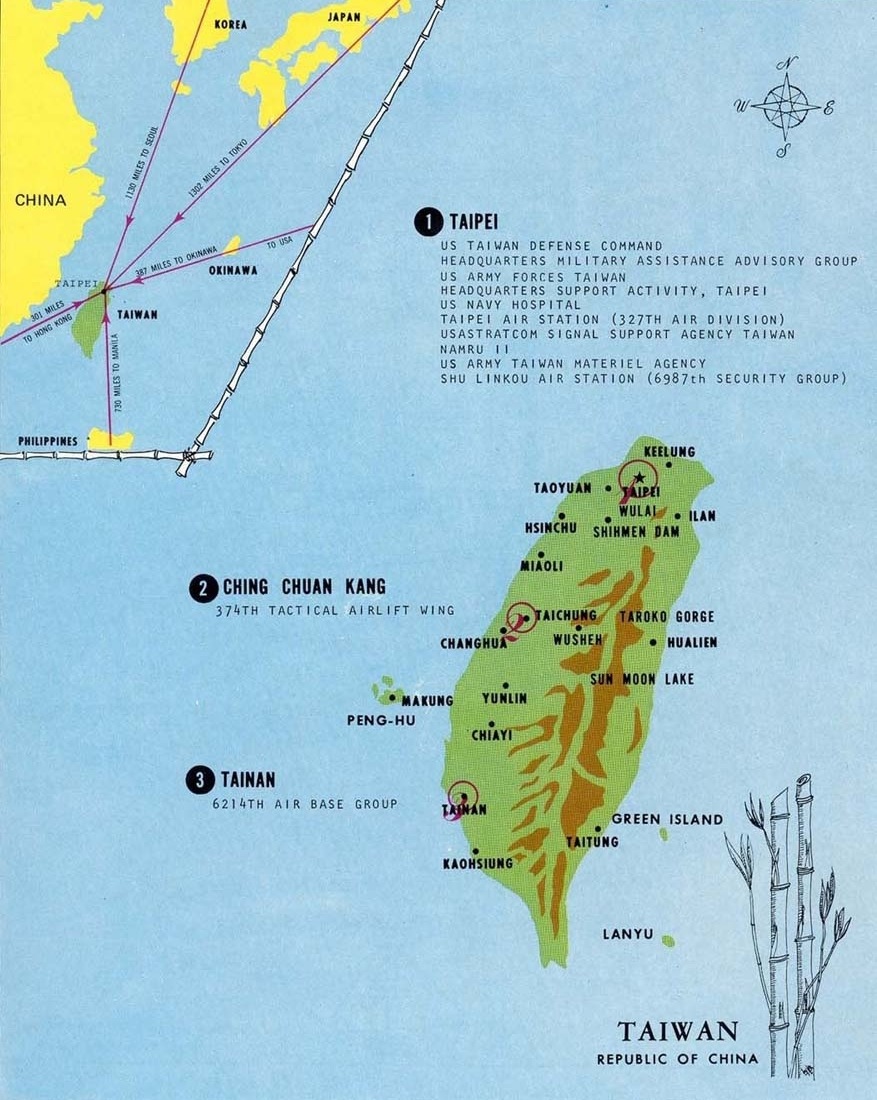
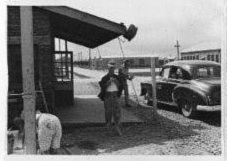
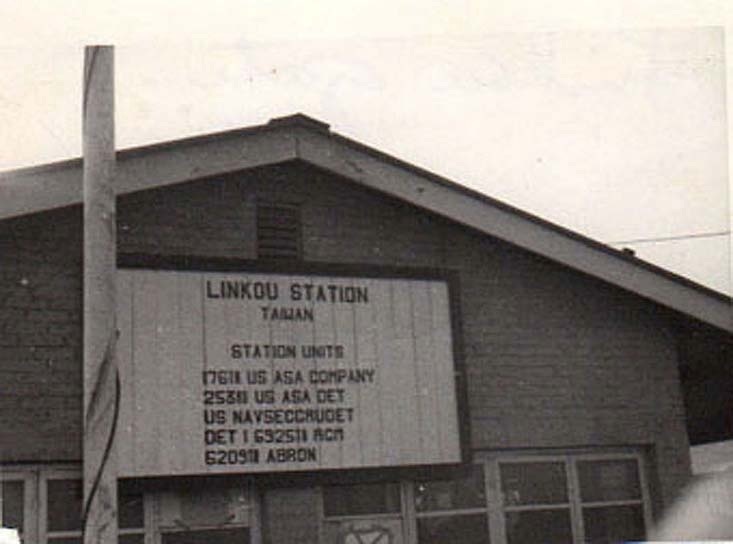
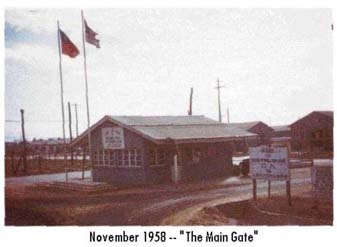
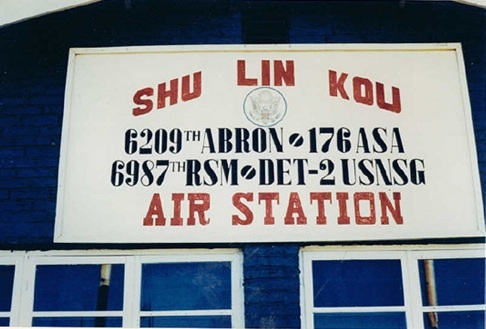
1.) 1957/58 shot of the Main Gate. Just over the top of the old Chevrolet is "The Last Resort" (US Army and USAF NCO Club). Barracks are visible in the center background.
Chronology of the 6925th RSM/RGM (Det. 1) and 6987th Security Group
2.) 1957 sign on the Guard Shack at the Shulinkou Main Gate. "Linkou Station Units" (from top): 176th US ASA Company, 253rd US ASA DET, US Navy SECGRUDET, DET 1 6925th RGM, 6209th ABRON
3.) Nov 1958 shot of the original Main Gate and Guard Shack located across from the Chapel (far right background). The sign over the Guard Shack's windows is also in the next photo.
4.) 1958 photo of the Shulinkou Air Station unit sign on the Gate Shack at the Main Gate (sign is also visible in the previous photo).


(Left Photo) In the 1957 photo above are the original Detachment 1, 6925th RGM officers. (From left) 1st Lt Edward J Black, Operations ; 1st Lt William Gross, Ops; Capt Donald E Weaver (Capt Weaver later became Linkou base commander as colonel, 20 Jun 73-Sep 74), Ops; Capt Frank Gerry, Ops; Major Robert F Stark, Commander (head of table); Capt John B. Kelley, Comm; 1st Lt Brice F Ballou, Ops; 1st Lt Hiram V Acevedo, Supply; and 1st Lt Ferdinand, Admin.
(Right Photo) 1957 shot of Major Robert F. Stark, Commander, and his senior NCOs at Linkou. First Sergeant MSgt. Elliot N. Nelson is in the front left. Two of the other three master sergeants are MSgt. Olsen and MSgt. Fullwood. Major Stark became the first commander of the 6987th RSM when it was activated on July 1, 1958. He remained commander until his departure March 1959.
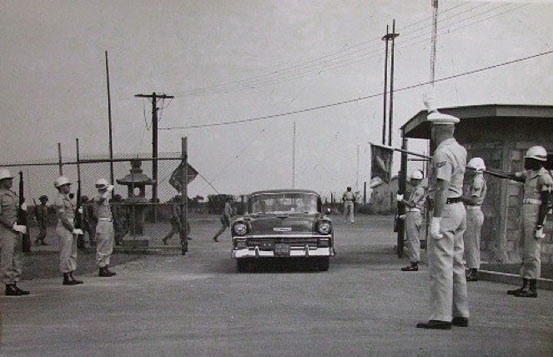
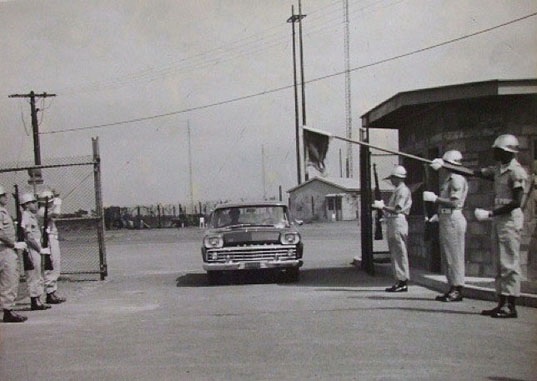
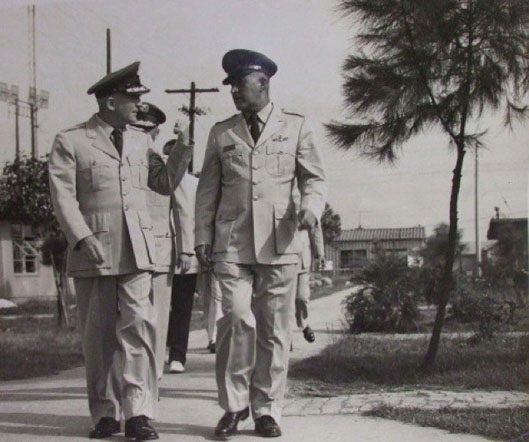
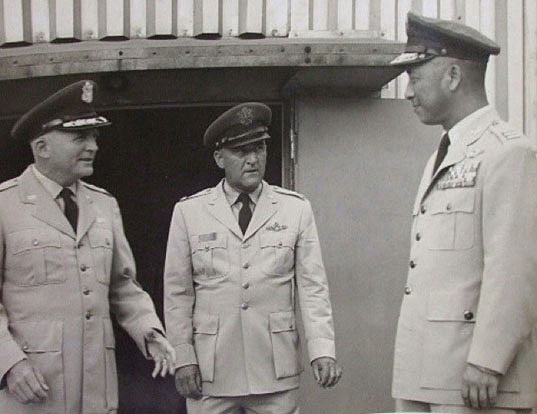
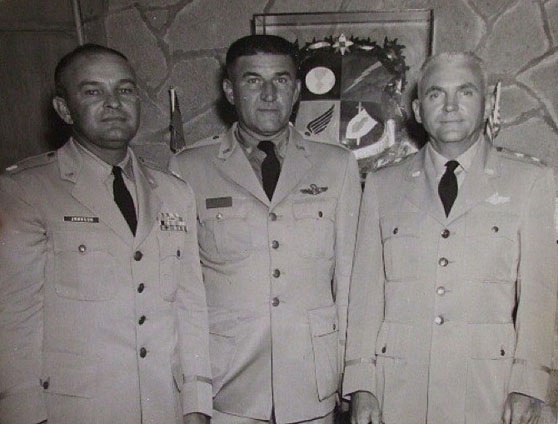
1.) Major General Gordon A. Blake, USAFSS Commander (Jan '57 to Aug '59), arrives at Linkou in his black 1956 Chevrolet Bel Air staff car in 1959 to tour the base and facilities of the 6987th RSM (Radio Squadron Mobile) activated on July 1, 1958. Members of the ChiNat Army are shown parading in combat gear outside the Main Gate in the left background.
2.) Chinese Nationalist Army general's staff car enters Linkou next through the Main Gate.
3.) Touring Shulinkou mid to late 1959 are Major General Gordon A. Blake (left) and Lieutenant Colonel Glenn T. Stitt. Lt Col Stitt became commander of the 6987th RSM on July 01, 1959 (until July 14, 1960), after Major Robert Stark's departure March 1959. Capt. Leonard C. Hess was interim commander from March to June 30, 1959.
4.) (L-R) Major Gen Blake, Lt Colonel Stitt, and a Nationalist Chinese Army general tour the base in 1959.
5.) (L-R) Lt Col Johson, Lt. Col Glenn T. Stitt, incoming 6987th RSM commander, and Maj Gen Gordon A. Blake, USAFSS Commander, during the general's 1959 Shulinkou visit.
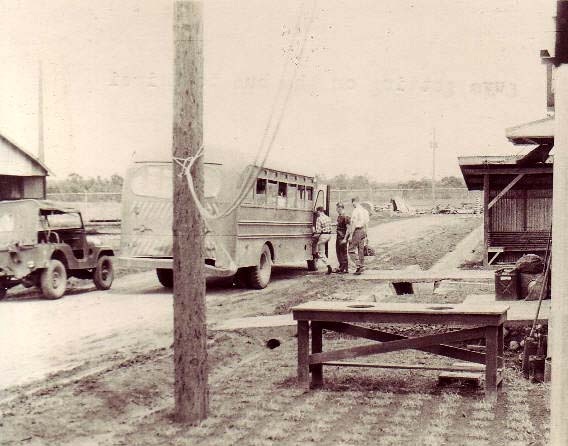
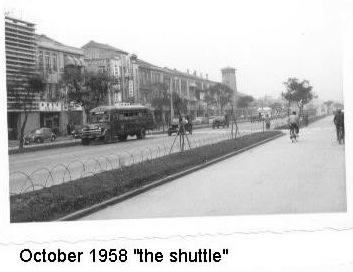
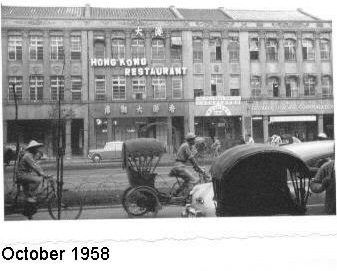
(1.) 1957 shot of the Linkou bus to Taipei. Frank Fredo (U.S. Army, 253rd ASA: '56-'58): "Getting on the bus to Taipei in 1957. Note the table in the photo above with the two holes in it...It was used to wash-up when we put metal bowls into the holes." [Nov. 16, 2007] ) (2.) The Linkou Bus in Taipei in 1958. (3.) The Hong Kong Restaurant in Taipei taken from the Linkou Bus 1958.
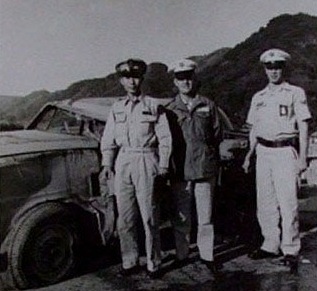
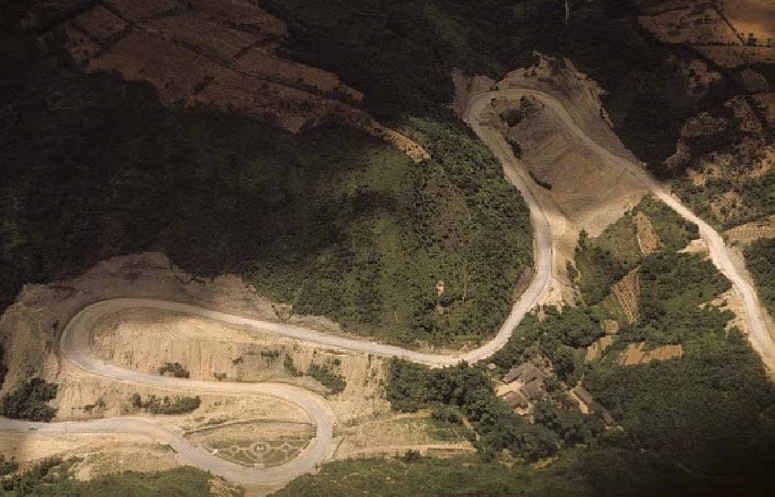
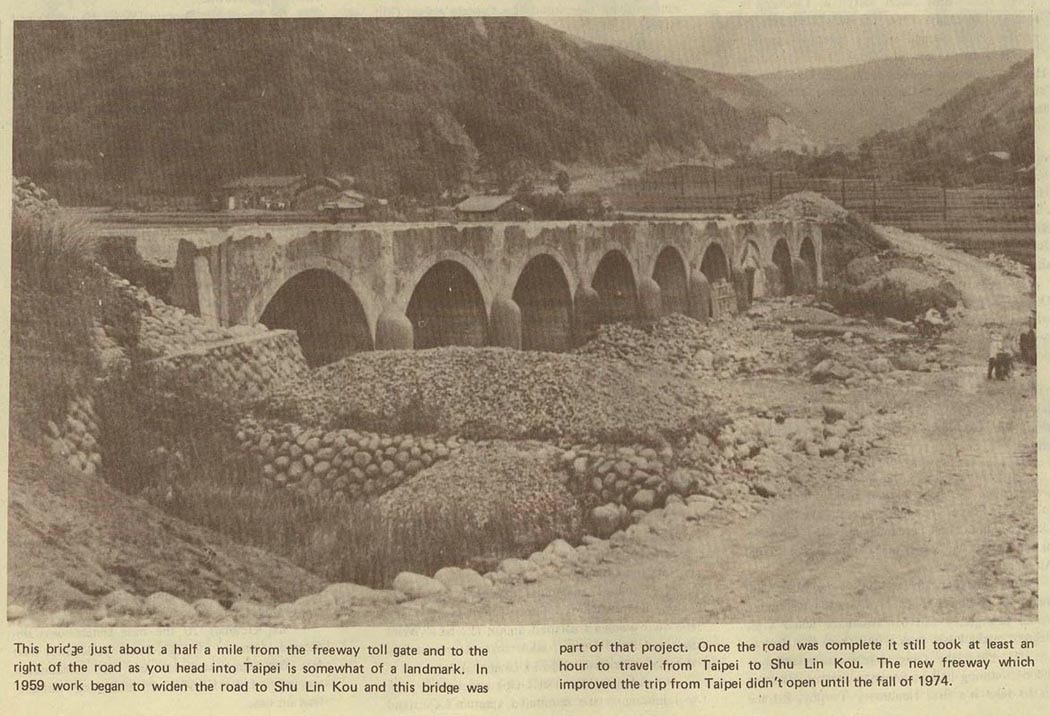
(1.) Circa 1957 shot of a ChiNat Army officer and Linkou Air Police next to a car that went over the side of the treacherous mountain road to Linkou. (2.) 1959 shot showing the road construction and paving on winding Linkou Road. The road construction was completed about 1960. (3.) 1959 bridge construction in conjunction with widening and paving the road to Shulinkou.
Alan Zeliff 1958 to 1960 - Taipei and the Road to Linkou:
Alan Zeliff (1958-60): "I was a 202 stationed at Linkou from 1958 to 1960. Before that I was stationed at Onna Point, Okinawa. The powers that be sent a group of us to Linkou after the Chinats shot down 33 MIGs over the Taiwan Strait with Sidewinder air to air missiles. I guess everyone was expecting some sort of Chicom retaliation, but for me going to Taiwan was just an adventure. Unlike our two-to-a-room dormitory-style barracks on Okinawa, living conditions at Linkou were nothing to write home about: unheated plywood barracks, so damp that the humidity quickly rotted by air force blues stored in my foot locker. To remedy these living conditions, four of us rented a house off Chung Shan Pei Lu in Taipei. We weren't supposed to do that, but the sergeants were good guys and looked the other way. Besides, they were doing the same thing.
The shuttle down to the MAAG compound was great fun too. We rode in open trucks called six-bys driven by Chinat drivers. The road was unpaved and we sped along, bouncing from rock to rock, past the adjacent Chinat army base, the village of Linkou and down the switchbacks to the main road to Taipei. By the time we got to Taipei we were filthy from all the road dust. Before I left for the US and my discharge in 1960, they did pave the road (see photos above) and what a difference that made. We even got to ride in buses after that.
We had a great time on Taiwan and we lived like kings on an airman's salary. Taipei back then had a population of about 700,000 and the tallest building was the MND building. I had occasion to return to Taipei in the mid-1980's. The city had changed so much that walking down Chung Shan Pei Lu it felt like I had never been there before. The only building that was familiar was the railroad station." [27 Oct 2010]
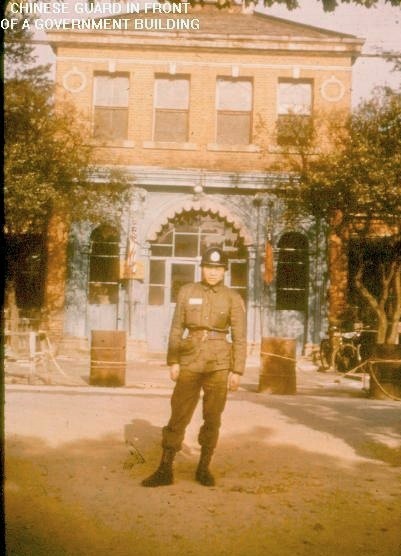
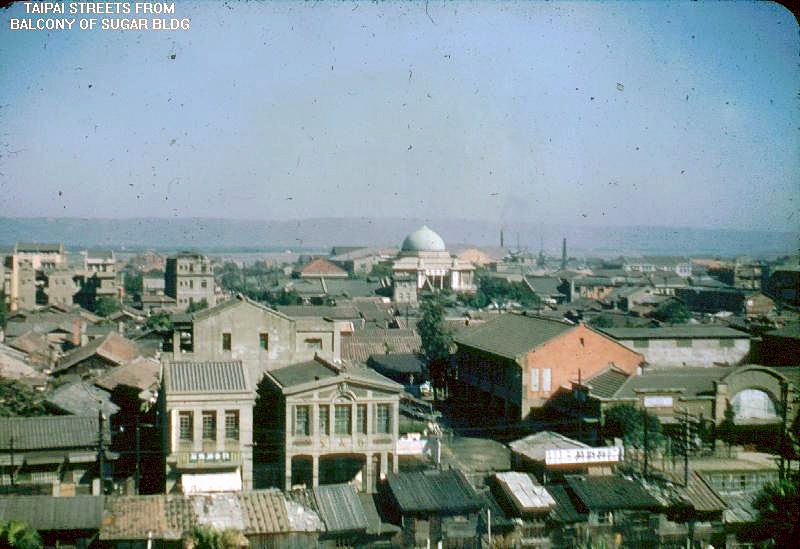
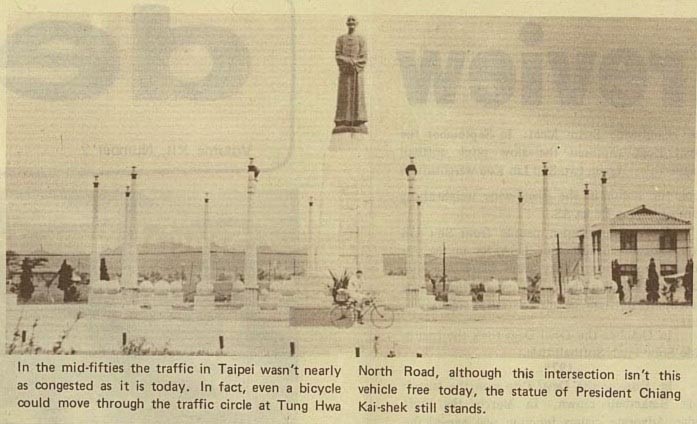
(Left Photo) 1955 shot of the first prefab mess hall (U.S. Army) on base that opened in June 1955. Photo by Bob Skinner (U.S. Army, 327 CRC, ASA: Feb '55 to Aug '55).
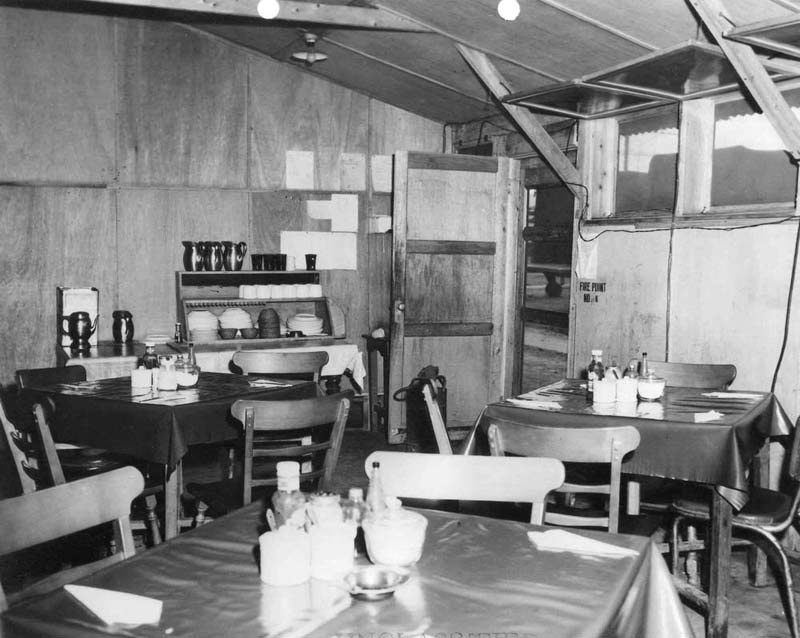 "The U.S. Army enlisted mens' (EM) club, originally housed in a tent, was moved to a prefab in December 1955 where it gradually acquired a snack bar, juke box, slot machines, draperies, and Chinese help in the form of waitresses, bartenders, and a cashier. (Source: History Office, Headquarters US Army Intelligence and Security Command, courtesy of K. Kovach)
"The U.S. Army enlisted mens' (EM) club, originally housed in a tent, was moved to a prefab in December 1955 where it gradually acquired a snack bar, juke box, slot machines, draperies, and Chinese help in the form of waitresses, bartenders, and a cashier. (Source: History Office, Headquarters US Army Intelligence and Security Command, courtesy of K. Kovach)
The enlisted mens' (EM) club was originally named the "Armies Club" when it first opened in December 1955 and was housed in the back of the old prefab corrugated metal mess hall (see photo on left) on the U.S Army side of base. In 1956 a new club was built (see photos below) across base at its new permanent location near the original Main Gate. The new club opened around Aug/Sept 1956 and was renamed "The Last Resort". "The Last Resort" was open only to the U.S. Army enlisted personnel on base until late 1958 when it was renamed the Linkou Club and was open to the Air Force, Navy, and Army.
Lawrence "Buck" Myers (May '55-Sep '56): "When I arrived, we were housed in tents and later on, one story buildings were built that housed about 20 per building. Our Air Force chow hall (see photo on left) was at the back side of the compound with the "EM/NCO/Officers club" ("The Armies Club") attached to the back of it. Not much of a club. It had a small bar and four or five picnic tables. Later on [late 1955] a new Air Force dining hall was built and the commander of the 13th Air Task Force, Gen. Benjamin O. Davis, came up [from Taipei] for the grand opening. An enlisted men's club [U.S. Army's, "The Last Resort"-see photos below] was built on base just before I left in late 1956." [06 Jun 2006]
William "Bill" Wood (Aug '57 to Jun '58): "The only club we had access to on base was a small room in the back corner of the Air Force dining hall building that had a private outside entrance/exit (could not access the club from inside the dining hall). It was an annex to the airman's club (Linkou Club) in Taipei. I had never heard of The Last Resort during my tour...we were not allowed on the U.S. Army side of the base and could not use any of their facilities.
There was a short order cook (grilled cheese sandwich was their specialty), could buy beer/alcohol, and could get $5.00 chit books on credit. There was no entertainment in our little "hole in the wall" other than a juke box and a slot machine. The most played song was "Detroit City" because of the lyrics, "I wanta go home"..."Fraulien" and "White Sport Coat" were also favorites. We recall there were no more than six tables...max capacity was probably 25." [30 Aug 2011]
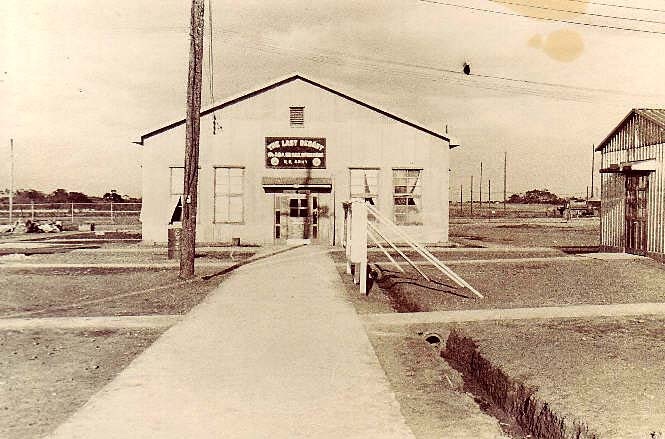
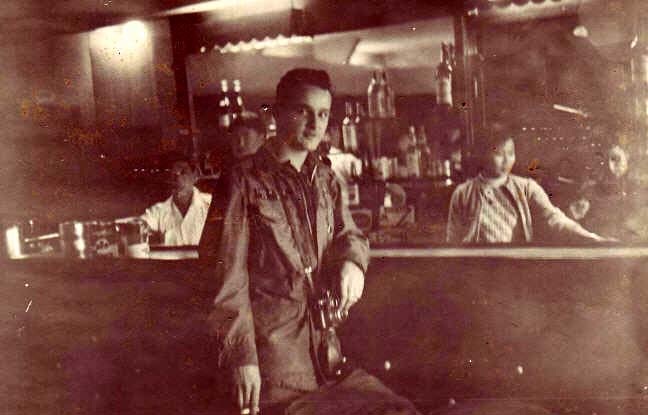
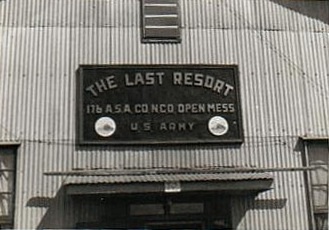
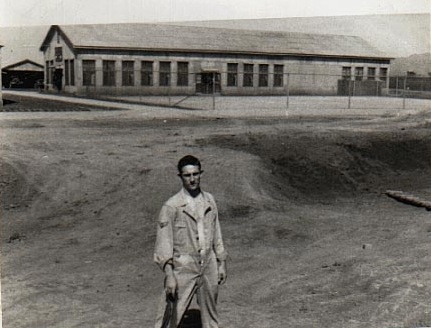
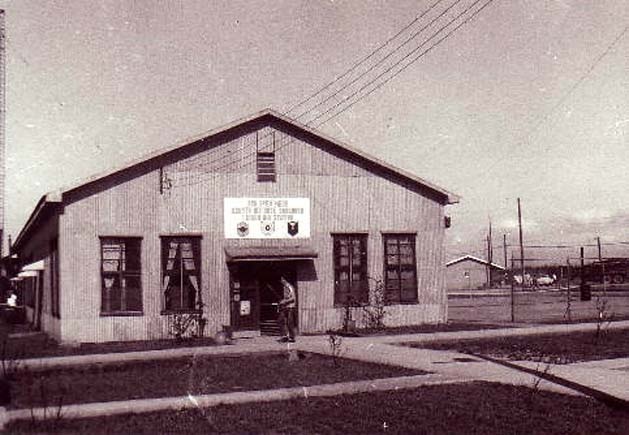
1.) 1956 shot of "The Last Resort", U.S. Army NCO Open Mess, and Orderly Room (far right of photo) at Linkou.
2.) 1956 shot of John Hyer, U.S. Army, at the bar in "The Last Resort", which was later renamed the Linkou Club.
3.) "The Last Resort, 176 ASA CO NCO Open Mess, U.S. Army" sign over the entrance to the club in 1958.
4.) May 1958 shot of John Denver standing in the freshly dug hole for the new swimming pool (see photos below). "The Last Resort", the U.S. Army NCO Club is in the background. The club's main entrance and sign (previous photo) are on the left end of the building in the photo..
5.) 1958 shot of the Linkou Club and the old Chow Hall (right background). In late 1958 The Last Resort's name was changed to the Linkou Club and was open to Air Force, Army, and Navy enlisted personnel at Linkou. Army, Navy, and Air Force unit numbers and insignia are on the sign over the club's entrance.
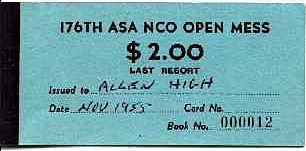
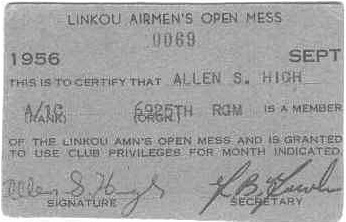
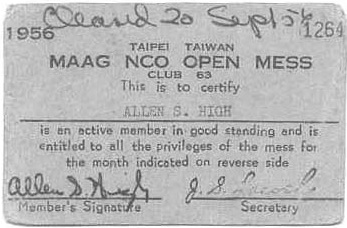
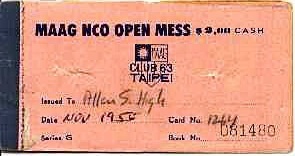
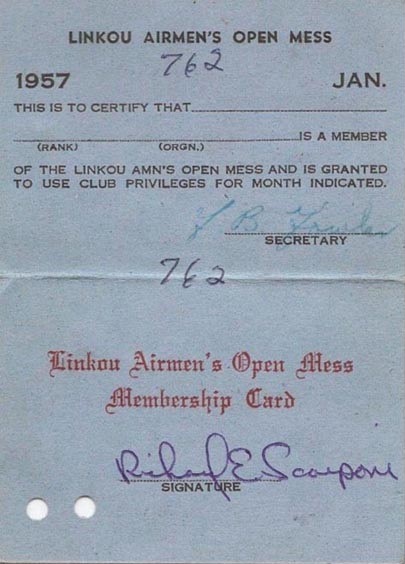
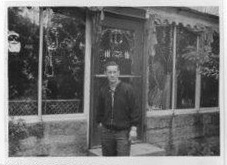 (Left Image) 1958 shot of Jim Perry in front of the Linkou Club Annex's "Branch No. 2" in Taipei. photo by Gary Scorby (1957-58)
(Left Image) 1958 shot of Jim Perry in front of the Linkou Club Annex's "Branch No. 2" in Taipei. photo by Gary Scorby (1957-58)
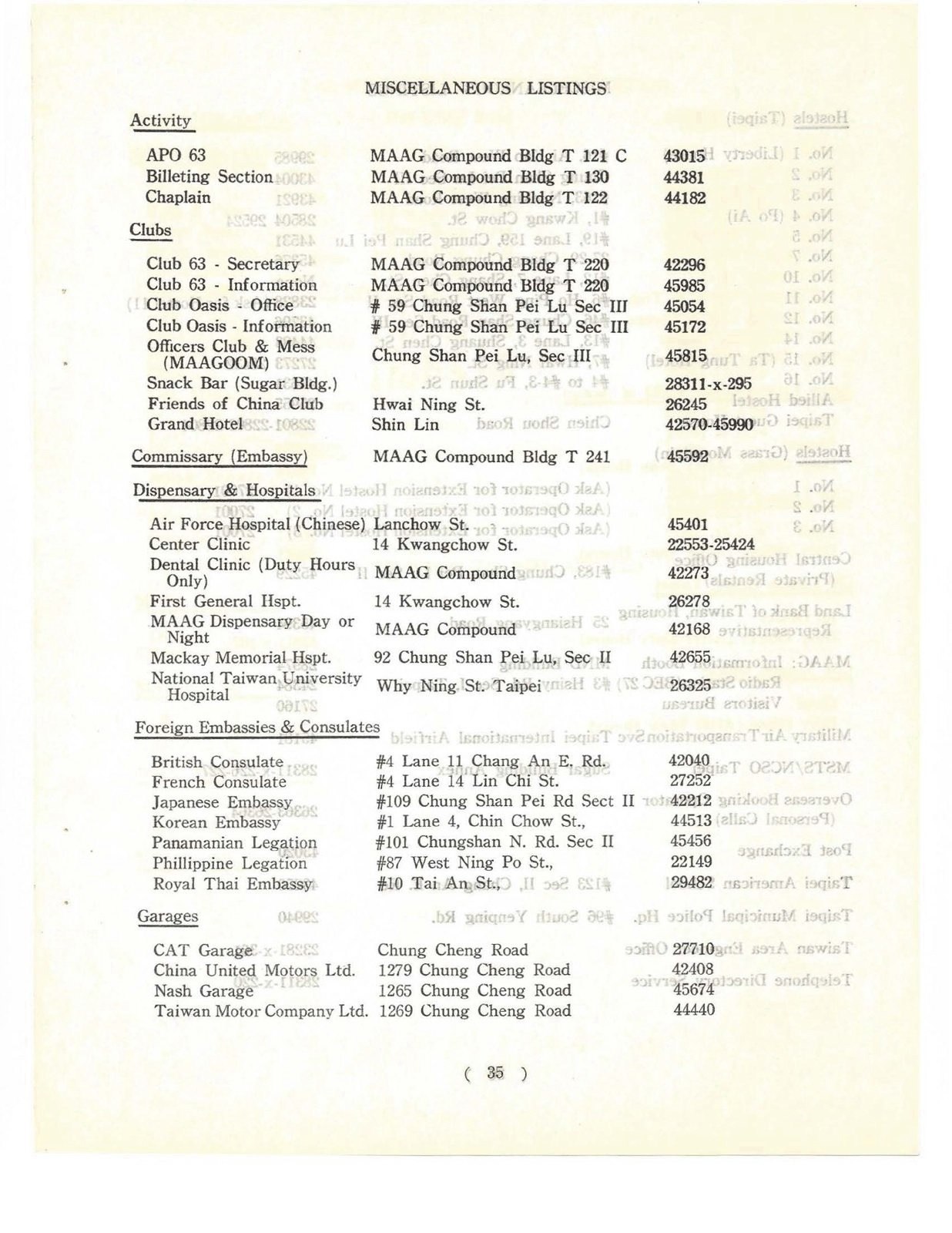 (Right Image) 1956 MAAG phone book page. Club Oasis was the Linkou Annex's original name. image provided by Kent Mathieu
(Right Image) 1956 MAAG phone book page. Club Oasis was the Linkou Annex's original name. image provided by Kent Mathieu
Harry Davis ('57-'59): "...I flew in from Clark AFB to the airport at Taipei in October 1957 and was met there by someone who took me to the Linkou Club Annex in Taipei [for overnight lodging]. ...We went to the airport in Taipei [Jan. 1959], and were told that the MATS airplane had mechanical problems and would not be flying out that day. About two weeks later we were allowed to fly back to the states. During those two weeks in Jan. 1959 we stayed in the upstairs rooms of the Linkou Club Annex in Taipei." [23 Mar 10]
William Thayer (U.S. Army, ASA: '60-'63, '73-'77): "During my tour between 1960 and 1963, Branch No. 2 was the main downtown Linkou Club. What we used to refer to as the Linkou Club Annex was a little apartment/storefront across Min Tzu Road facing Chungshan North Road...about 100-150 yards to the left of the Linkou Club as you exit the downtown club. The little annex was where the Linkou bus dropped and picked up its passengers. It was a very small storefront operation and I believe that they did, in fact, have temporary quarters upstairs although I never knew anyone who was quartered there. It was located essentially in an apartment house, but the downstairs had a bar and tables and a fast food operation. It could hold about 20 to 30 people at once." [21 Sep 08]
Don Lynch ('56-'57): "My first Linkou tour was June 1956 to July 1957. You know the stories...brick walkways, central shower with "occasional" water, 6 by 6 busses, ROTTEN chow, tiny club operated out of the back end of the Mess Hall, "drive-in" movies (fair weather only) on the grassy hill behind the Army side of base, etc., etc. In early 1957, the "Annex" opened in Taipei. It was a converted house on the site where the Linkou Club was later built. It was a place to sleep (no showers) in Taipei if you missed the last bus and didn't want company. It was cheap (around 50 cents) and had a small dining area that served ham & egg fried rice and a couple other inexpensive items. To us it was like a five-star hotel." [19 Sep 08]
Luther Deese ('60-'61, '64-'66): "We called it the Linkou Annex. The entrance was on the street to the right of the entrance to the main club (which at that time was back off the street a ways). The annex had a full service bar downstairs and served short orders from the main club kitchen. You could rent a bed (double bunks) and wall locker upstairs for 75 cents a night." [19 Sept 2008]
(Image on Right-Double Click to Enlarge) The "Calendar of Events Linkou NCO Clubs April 1960". The calendar's heading reads, "Branch No. 2: Open 0700-2330 hrs daily for food, drinks and provides temporary quarters [upstairs]". The Linkou Club in Taipei was referred to as Branch No. 2 when it first opened in 1958 through the early 1960s. The second floor of the Linkou Club (Branch No. 2) was originally used for temporary lodging. The club's second floor was later designated as the Top Five Lounge for NCO ranks E-5 and higher only. It had with a bar and tables.
The Linkou Annex was a converted house located on Chungshan North Road located across from the MAAG West Compound. It first opened in 1957 and closed circa 1963. Downstairs was a bar with several tables and a kitchen. Upstairs were about 12 double bunks and showers. Lodging was around 50 cents a night.
Image provided by Jim Primus USAF (SLK: '58-'60) courtesy of "LinkouNavy.com".
"Around 1958 and 1959, a few construction monies began to trickle in and a few buildings, such as the Dining Hall, the Headquarters building, and Officers' Mess (Officers Club) were started. As time went on, then came the Base Exchange (BX), the Theater, the Bowling Alley, and the luxury of air conditioning." ( source: Shulinkou Devil Dog base newspaper, Feb. 23, 1977 edit.) provided by Roger Jarvis (SLK Sep '75 to 31 Mar '77)
Gary Scorby, Sept. 1957 to Dec. 1958
Gary Scorby (1957-58): "Notice the letter in my left shirt pocket (photo below), that was from my wife to be at that time and now 51 years of marriage later. I took marriage counseling from Major Stark (commander). He came out of his office to see me and said, 'It isn't one of these bar girls is it?', I said, 'No sir, it's a girl back home'. He said, 'Oh well, come on into my office'. I chuckled silently..." [24 Apr 2010]
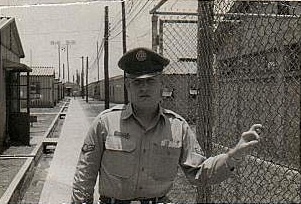
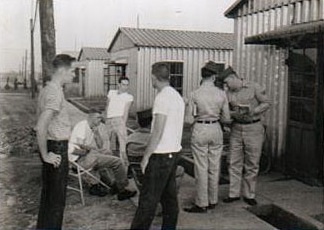
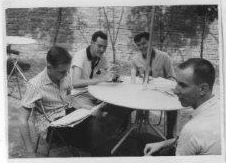
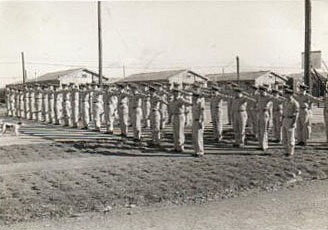
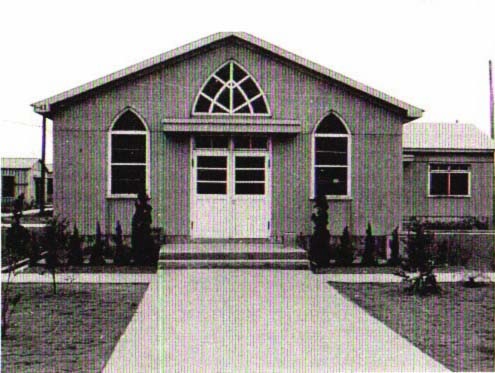
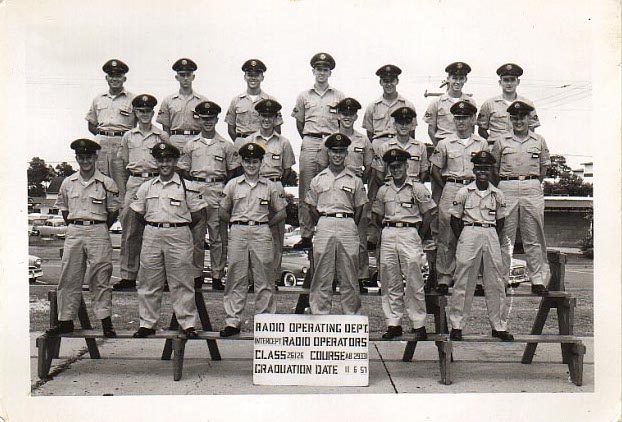 1.) 1958 shot of A2C Gary "Wong" Scorby (1957-58) standing next to the new Swimming Pool fence and Pool House/Maintenance Building behind it. The back door to Gary's barracks is on the far left and the antennas on the backside of base are visible in the background.
1.) 1958 shot of A2C Gary "Wong" Scorby (1957-58) standing next to the new Swimming Pool fence and Pool House/Maintenance Building behind it. The back door to Gary's barracks is on the far left and the antennas on the backside of base are visible in the background.
2.) 1958 shot of a group of Gary Scorby's friends at the back door of their corrugated metal, open-bay barracks (built in 1956). John Denver (center background) is wearing T-shirt and stretching. The two wearing uniforms (far right) are Jack Lyons (back to camera) and SSgt. Mike Weir. The others are "unidentified".
3.) 1958 shot of a group of guys from Shulinkou outside the Linkou Club Annex on Chungshan North Road across from the MAAG Compound in Taipei. John Hallam is second from the left (see story below). The others are "unidentified". (The unidentified airman on the far right was a Chinese linguist at Linkou.)
4.) "Dress right, dress...!" 1958 shot of an open ranks inspection at Linkou, which was the only inspection at Linkou during Gary Scorby's tour, 1957-58.
5.) 1957 shot of the Linkou Chapel. The new base Swimming Pool (see photos below) was located right behind the Chapel.
(Right Photo-Click to Enlarge) Gary Scorby's 1957 Intercept Radio Operator's Class at Keesler AFB, Miss. (graduation date: Nov. 6, 1957). Top Row: Morris (far left), William Lake (second from end-far right). Second Row: Gary Scorby (far right), Forest Lacombe (third from far left). Bottom Row: Robert "Dr." Kinsey (far right), "Abdul" (third from far right), (Rosario) Cardone (second from far left with rope).
Gary Scorby (1957-58): "John Hallum and I went through Keesler together and were assigned to the 6925th RGM at Clark Air Base, Philippines. John was sent to Shulinkou 6925th RGM, Det. 1 from Clark AB. However, three of us were chosen to stay behind at Clark to play football. We met two fellows passing through on the way back to the U.S. at the Airmens Club one night and they painted us a rosey picture of Shulinkou. We were in the orderly room the next day volunteering for Linkou. We flew to Taiwan on a USAF C-4, the safest flight I have ever been on. The crew chief issued us a parachute and fitted us up. He told us if we had to bail out, just roll out the door and pull the ripcord when we saw the tail of the plane. He said if the chute failed, bring it back and he would give us another. I slept on mine." [13 Mar 13}
William "Bill" Wood (Aug '57-Jun '58): "The swimming pool was dug while I was there. Every shovel full of dirt was removed by laborers with a bucket on each end of a pole across their back and neck. I was the first person to swim in the pool, although illegally. The pool had been filled with water for testing. The fence was not up and after a couple of San Miguel's, I decided to take a dip. I dived in, went across the pool underwater, came out the other side and headed straight to the barracks. A few minutes later a couple of SPs had followed my wet footprints to the foot of my bed. One said to the other 'Heck, I don't see anything, do you...?' That was the end of that." [21 Mar 2004]
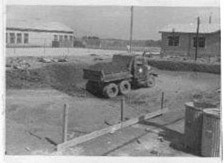
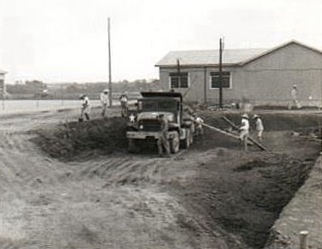
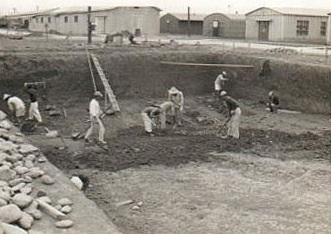
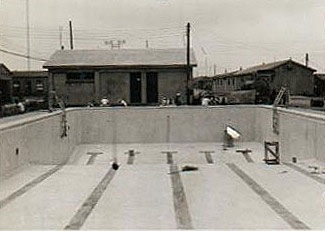
Bill Wood, Aug. 1957 to June 1958
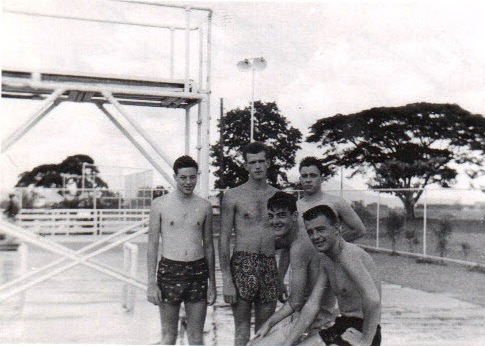
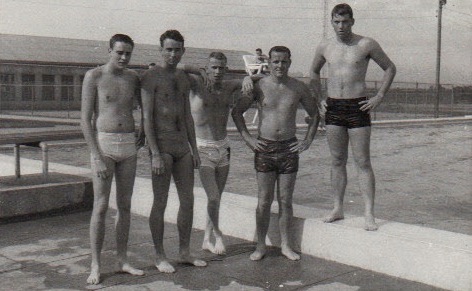 (1.-above) Pool construction Jan 1958. Shown are "The Last Resort" (far left) and Chapel (right).
(1.-above) Pool construction Jan 1958. Shown are "The Last Resort" (far left) and Chapel (right).
(2.) Jan/Feb 1958 shot of Taiwanese workers digging the pool by hand. In the background is the rear of the Chapel. "The Last Resort" (US Army NCO Club) is just off to the left.
(3.) Getting ready for cement. Barracks and other buildings are in the background.
(4.) Waiting for water. The new pool and pool house were completed in late May or June 1958.
(Right Photo) May/June 1958 shot of Bill Wood's buddies at the brand new pool and diving board (far left). (L-R) Bill Miller, Purvis Graham, Al Fessenden, Bud Garrett, and Dick Herndon. "The Last Resort" is in the left background. It was renamed the Air Force "Linkou Club" later that year (1958).
(Left Photo) Bill Wood's friends at the new pool May/June 1958: (L-R) Haglin, Bill Clark, "Guy", Sonnier, and "Vouk".
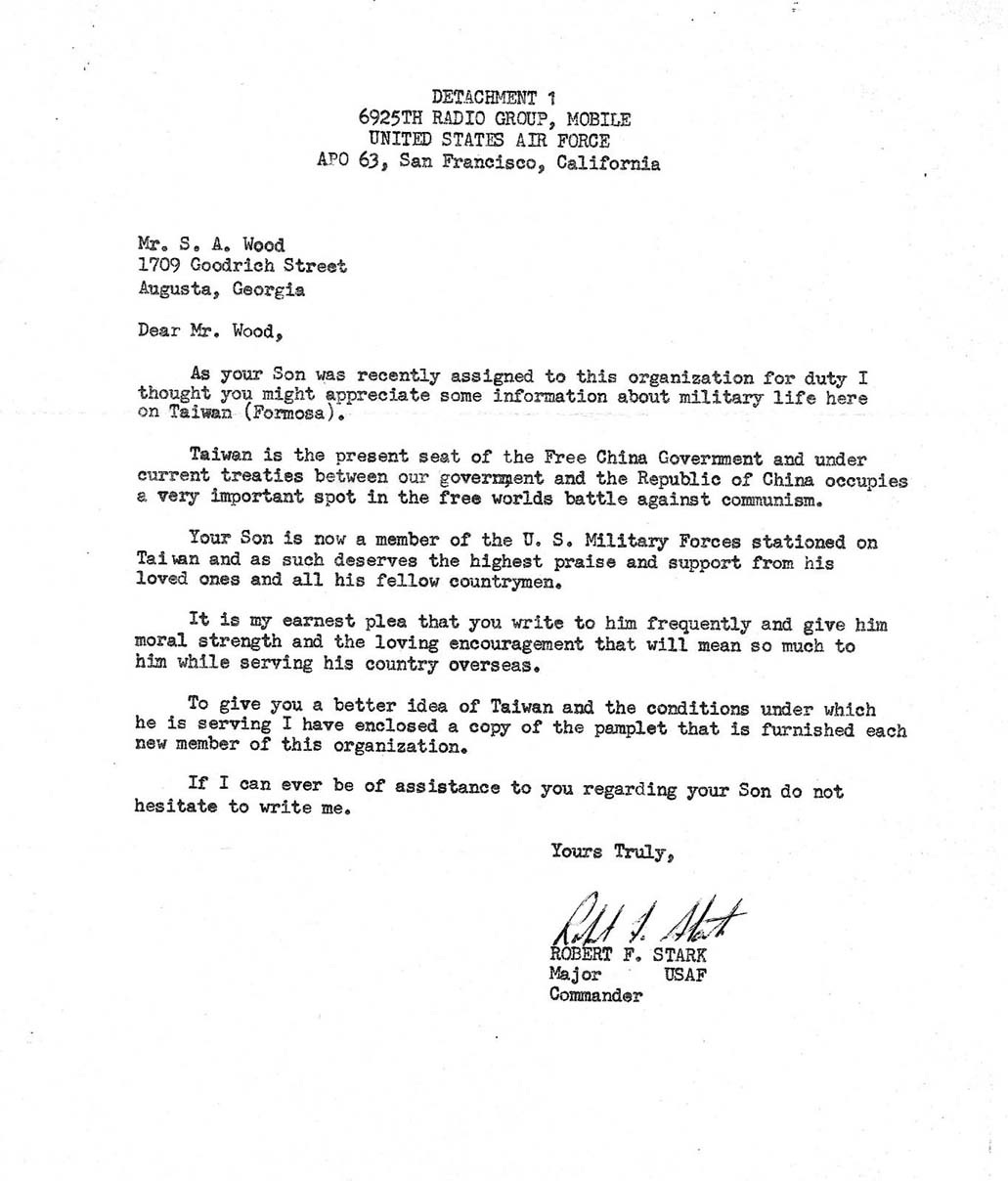
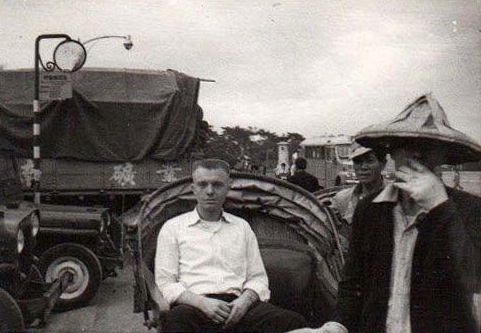 (Left Photo) Bill Wood in Taipei 1957/58. Images (right & left) provided by Bill Wood
(Left Photo) Bill Wood in Taipei 1957/58. Images (right & left) provided by Bill Wood
(Right Photo-Click to Enlarge and Zoom In) 1957 letter home from Maj R. F. Stark, Commander.
William "Bill" Wood, MSgt. USAF (Ret.): "I arrived at Shu Linkou (Det. 1, 6925th RGM) as an A/3C August 1, 1957 and departed in June 1958. I volunteered for the transfer from Clark AB to Linkou because of a shortage of 292X1s. When I arrived there were only enough operators for two tricks...I was on Trick 2. We worked 12-hour shifts (12 on, 12 off) and later went to 6-hour shifts (6 on, 6 off). Eventually, enough operators arrived so we had four tricks with one trick on 'break' at all times.
We were in the barracks next to the central shower building and just across from the "round" telephone exchange building. The 'laundry' was in the building located at our back door and the mail room was at the opposite end of that building.
The communication cable from Operations to the DF site had to be replaced, so each trick on break worked to dig the trench for the new cable with shovels (see DF cable photo below at "The Quemoy Crisis"). Another project was replacing the brick sidewalk from the Operations Building to the guard shack. Again, the trick on break was detailed to remove each brick, wash it, and lay it back down so a concrete sidewalk could be poured over the top of the bricks.
During my time at Linkou, we were not allowed to go to the 'Army side' of the base or use any of their facilities (including The Last Resort-see photos above) until shortly before I left in June 1958 when the Army allowed us to use their theater. Previously, we watched movies in our chow hall after dinner. We ate, cleared the building, formed up outside, came back in, paid a quarter, sat down at the same table where we had just eaten, and watched a movie projected on the wall by a Bell & Howell reel-to-reel projector.
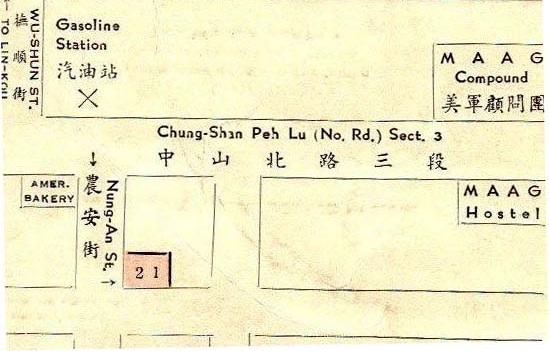
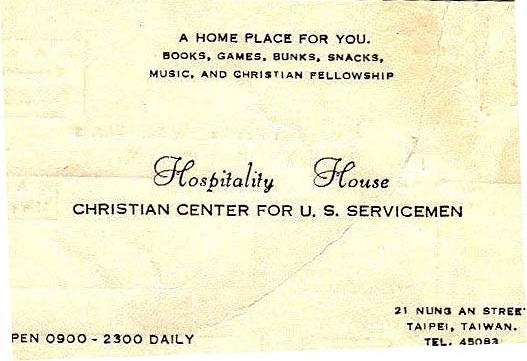 The trips to Taipei on the unpaved road was harrowing, to say the least. The only transportation we had for a long time was a six-by-six...we had to hold the canvas cover down to keep from getting soaked. Near the end of my tour, the Army confiscated an old bus and we were able to ride 'inside'.
The trips to Taipei on the unpaved road was harrowing, to say the least. The only transportation we had for a long time was a six-by-six...we had to hold the canvas cover down to keep from getting soaked. Near the end of my tour, the Army confiscated an old bus and we were able to ride 'inside'.
The Airman's Club on base had an annex (the Linkou Club Annex) in downtown Taipei. It was a good place to reconnoiter while on three-day break. A group of missionaries ran a hostel (located behind the Florida Bakery) near the Linkou Club Annex called the Hospitality House (card on right) that was strictly for American military personnel. If you didn't want to sample the local wares, you could always get a clean bed if you happened to miss the last ride back to Linkou." [21 Aug 2011] images on right by Bill Wood
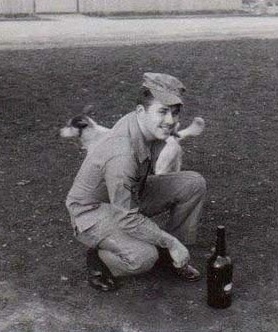
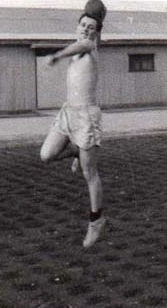
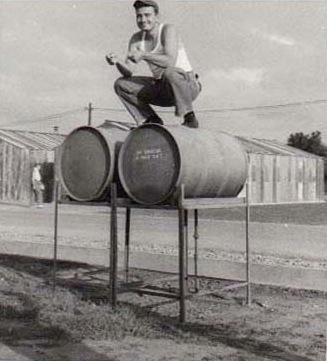
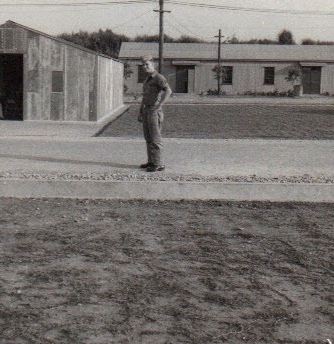
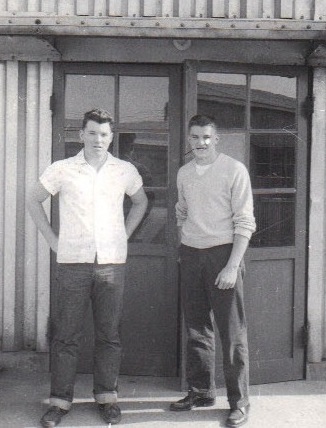
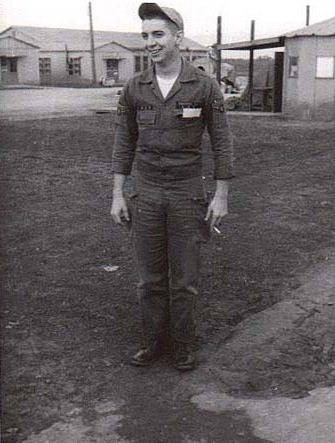
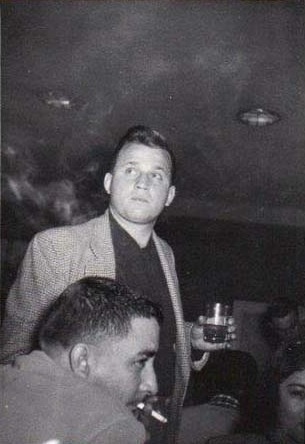
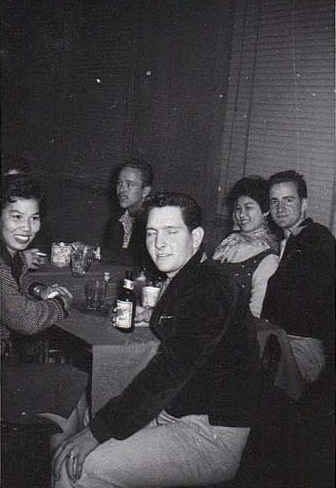
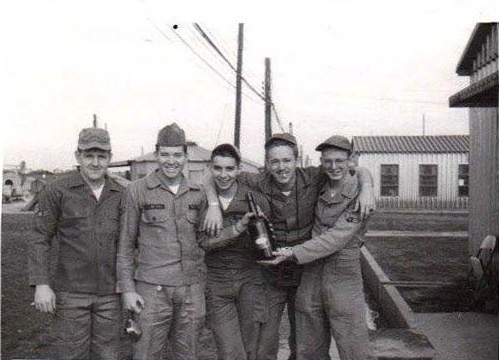
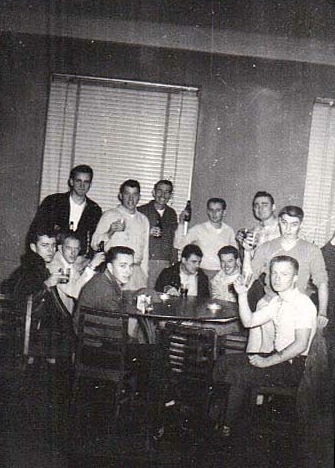
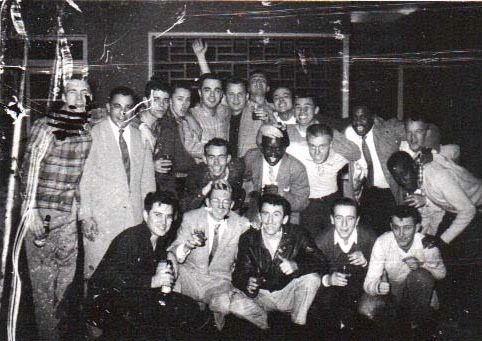
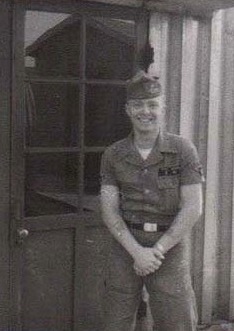
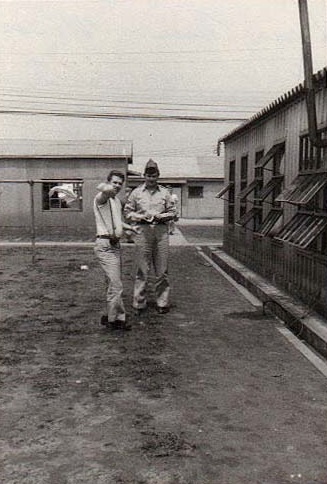
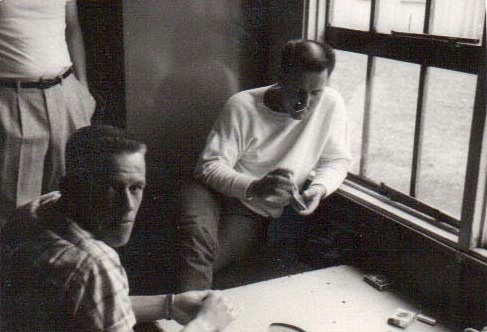
Trick 2 members 1957/58:
TOP ROW above: (1.) David Cain (MA) and "Queenie" the Linkou Air Station mascot. (2.) Don Brideau (MA). (3.) Roger Morris (NJ). (4.) Herbert Caudill (GA). (5.) Dick Herndon (left-FL) and Jack Heim (TN). (6.) Honore Gendron (NH). (7.) SSgt. Quinones (seated-foreground) and 1st Lt. Black (Trick 2 Flight Commander) at a 1958 flight party in Taipei. (8.) Tom Rose (front), Mike Griswold (right), and Dick Stein (background).
BOTTOM ROW above: (1.) (L-R) Bud Garrett (IN), Dick Herndon (FL), Honore Gendron (NH), Dick Stein (NY), Rufus Warmkessel (PA) outside barracks (far right). (2.) (Seated L-R) Mike Slavens (front), Al Fessenden, James Parker, Jose Perez, Dave Cain, Bill Wood (white shirt). (Standing L-R) Mike Griswold (far left), Dick Herndon, Purvis Graham, Donald Brideau, Roger Morris, Honore Gendron.
(3.) (First Row-Kneeling L-R) Dugas, Warmkessel, Pouclier, Unidentified, Brideau. (Second Row-Stooping L-R) Graham, Milburn, Wood, Harding, Fessenden, Green. (Third Row- Standing L-R) Ollinger, Quinones, Slavens, Parker, Sanford, Black, Morris, Paul, Arsiga. (4.) Bill Wood. (5.) David Cain (left) and Lee Guptill. (6.) Al Fessenden (left) and Bud Garrett.
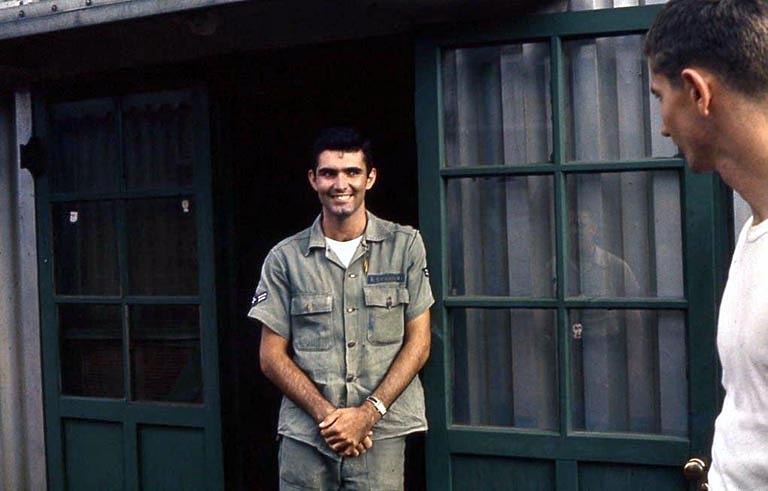
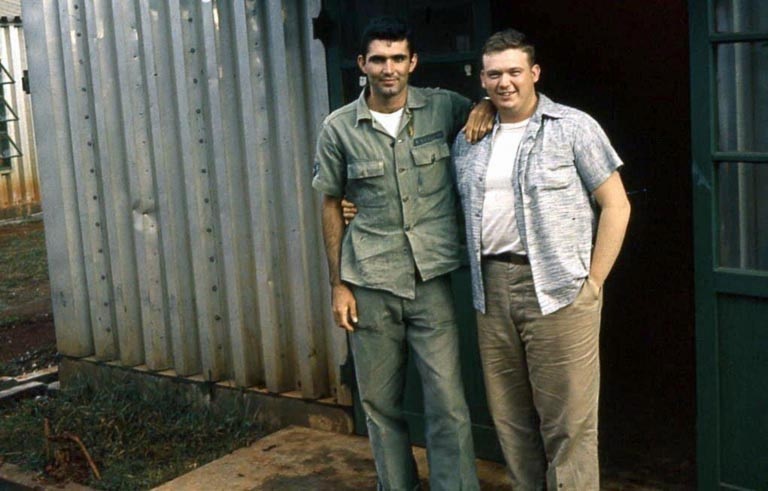
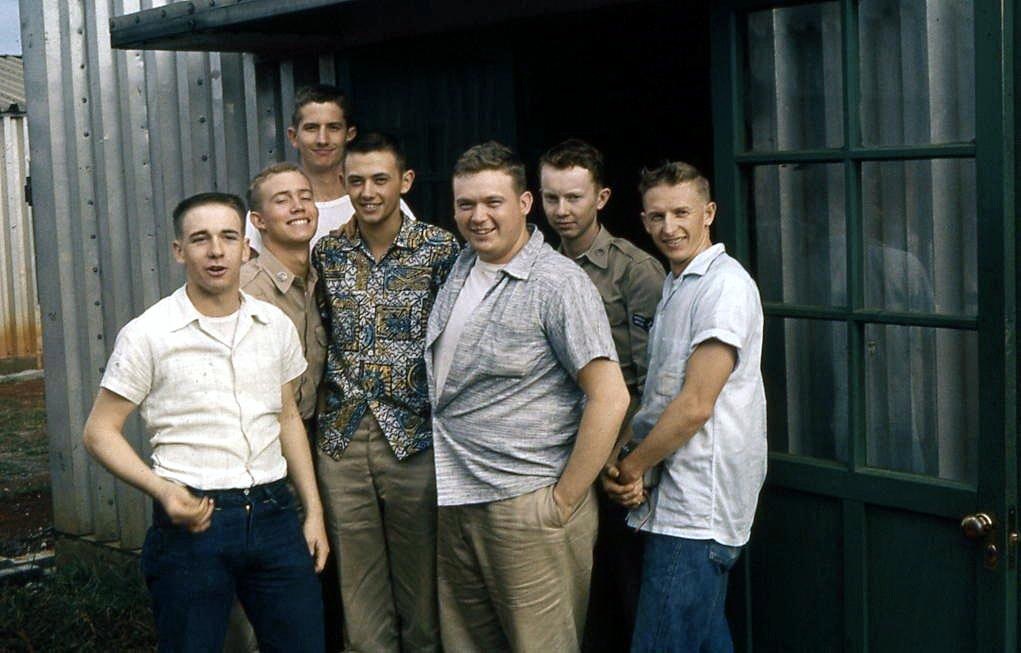
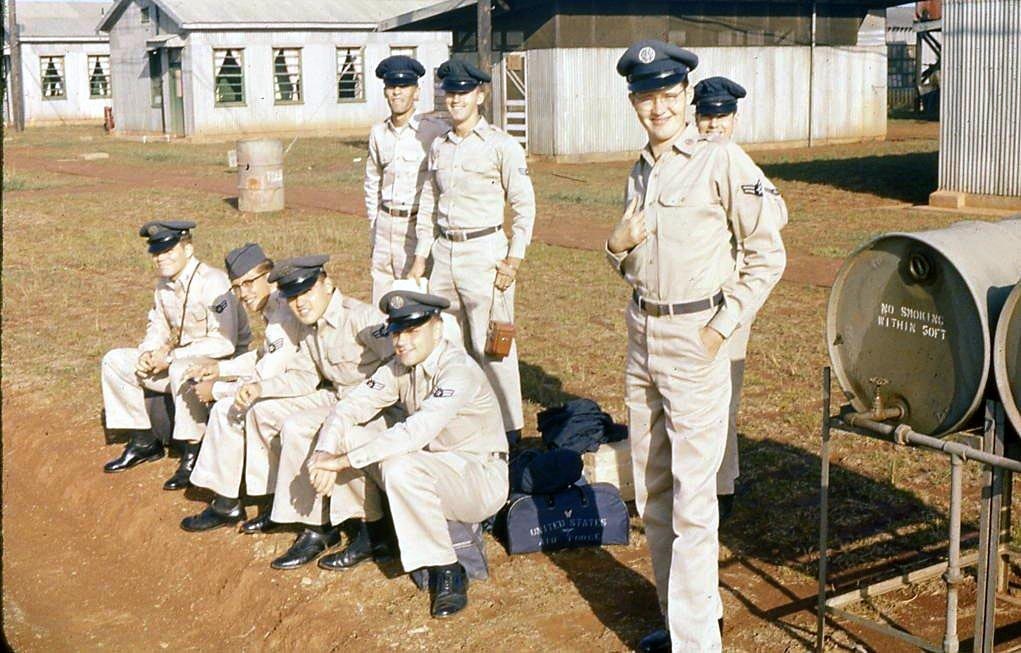
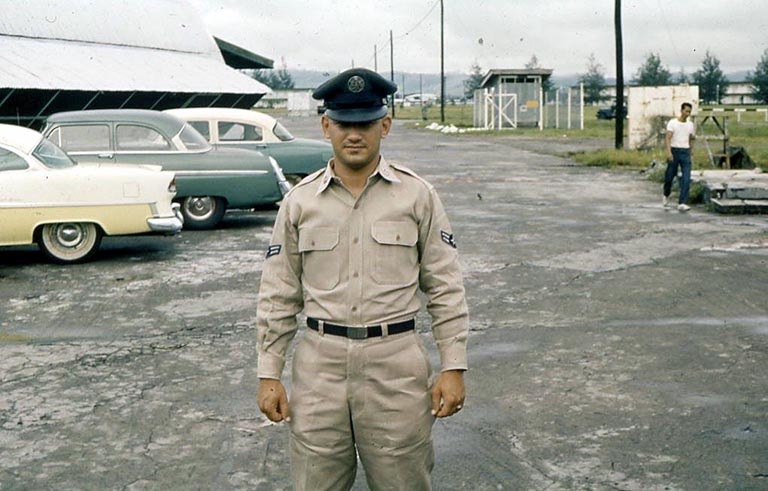
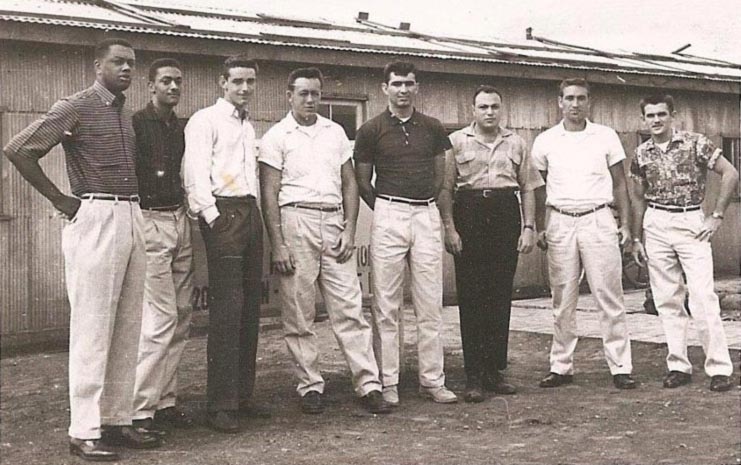
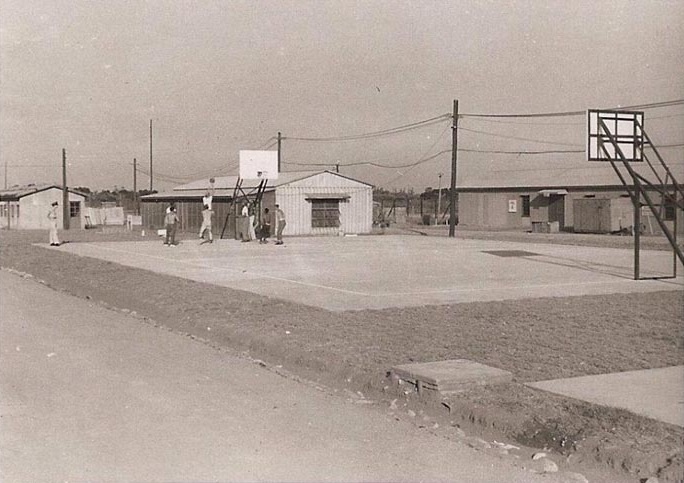
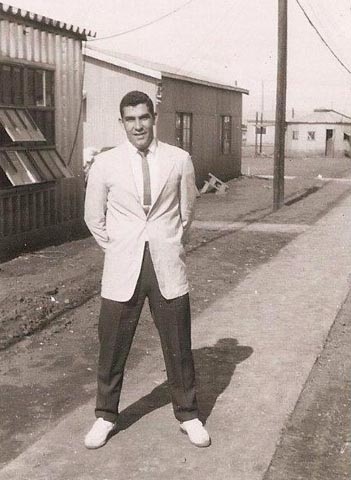
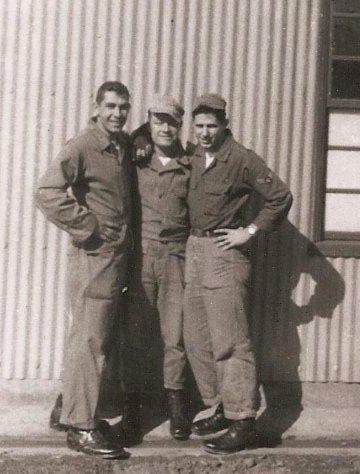
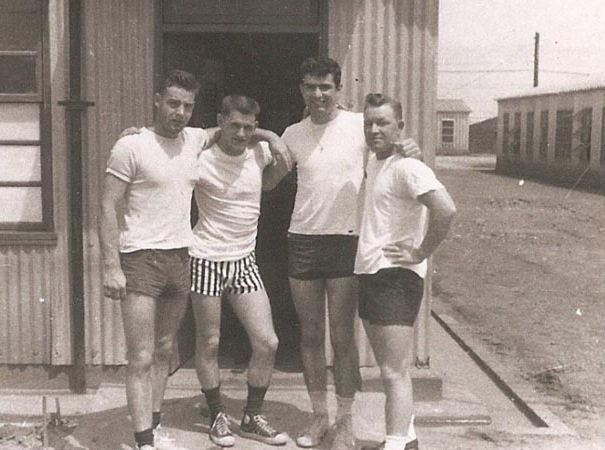
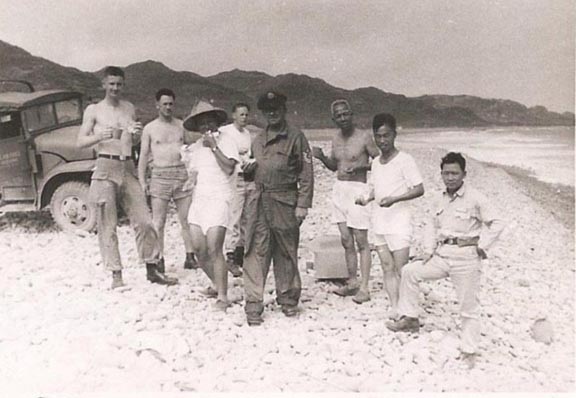
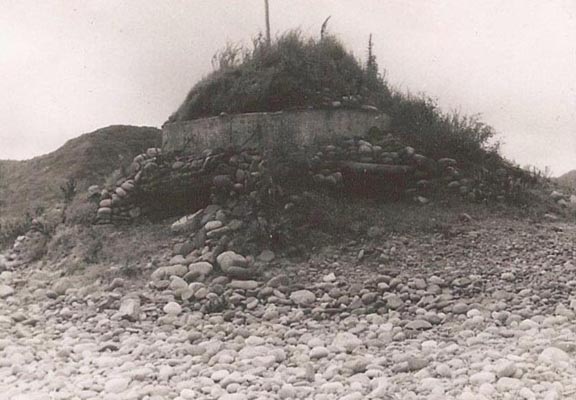
TOP ROW above: (1.) Richard (Dick) Scarponi and unidentified (far right). (2.) Dick Scarponi (left) and Unidentified. (3.) Group unidentified. (4.) On the way home 1956. Barracks in background. (5.) Unidentified. Chow hall visible on far left behind the "classic" cars.
BOTTOM ROW above: (1.) Linkou 6925 RGM "Aces" 1956-57. 1956/57 Linkou championship basketball team. Dick Scarponi in center (dark shirt). All others are unidentified. (2.) Linkou basketball court. (3.) 1956/57 shot of Dave Columbus (Keene, NH) outside barracks (1956-57 6925 RGM "Aces"). (4.) (L-R) Dave Columbus, "Whitey" Vause, and "Willie" Williamson 1956/57. (5.) (L-R) Bill, Siler, Dick Scarponi, and "Whitey" Vause 1956/57. (6.) Trip to beach 1956/57 (all unidentified). NOTE: Additional photos by Dick Scarponi are posted below at "Linkou Barracks 1956 to 1958".
(Right Photo) 1956/57 shot of a ROC bunker on the Taiwan coast to counter a ChiCom invasion from the Chinese mainland.
Don R. Lynch (Jun '56-Jul '57): "...We had no APO of our own in 1956; we had to use "APO 63" [Taipei's APO] for all our mail and our water supply was trucked to the Hill from somewhere else. When the water truck didn't arrive for whatever reason, we had no showers (se photo below) and many of us developed what we called crotch-rot from not being able to shower." [April 27, 2003] Don R. Lynch . Note: The 63 Club's name was derived from "APO 63", which was the US military's "Air Post Office" address for Taipei.
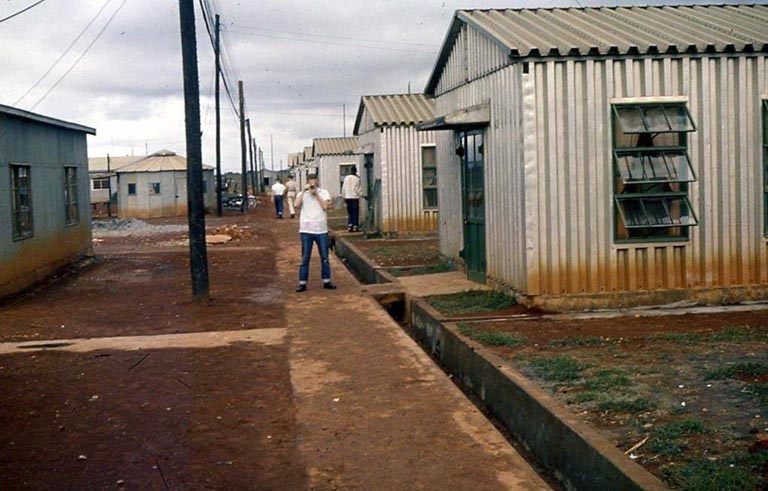

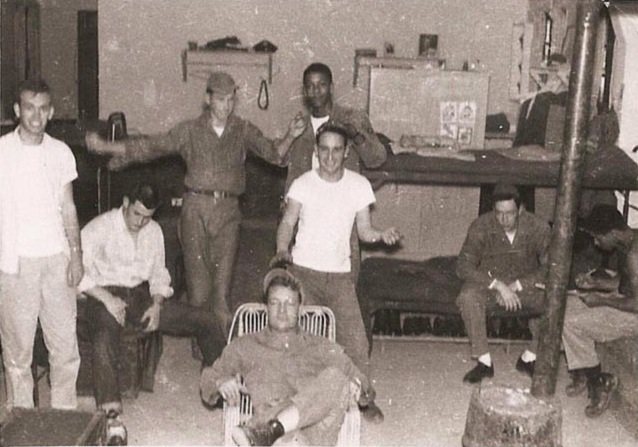
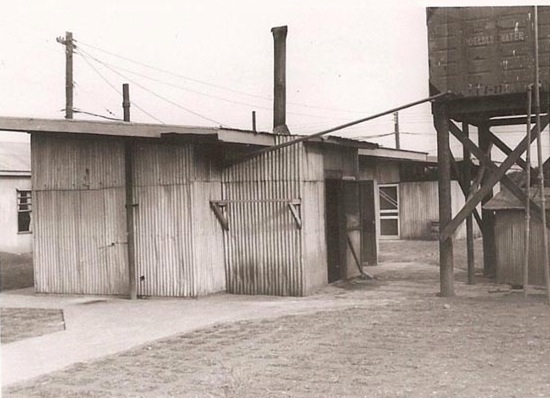
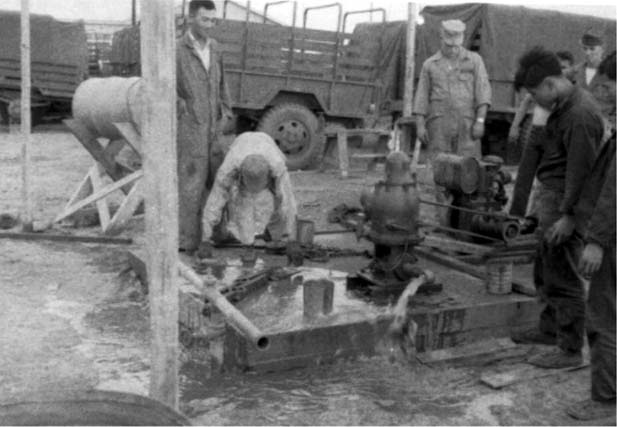
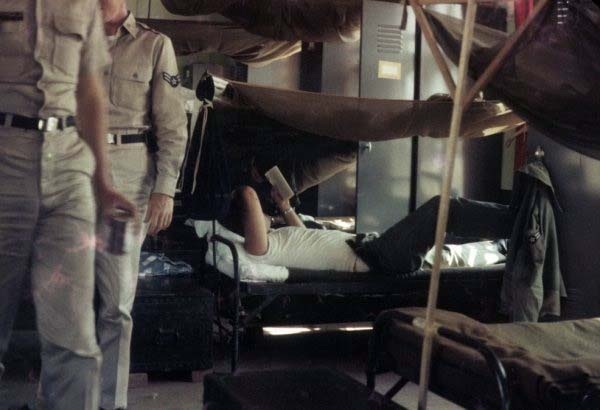
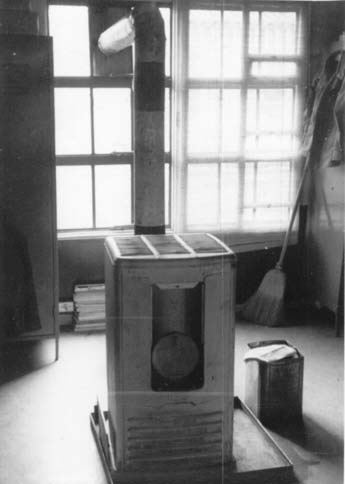
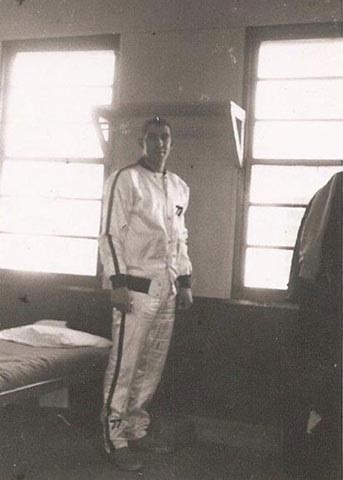
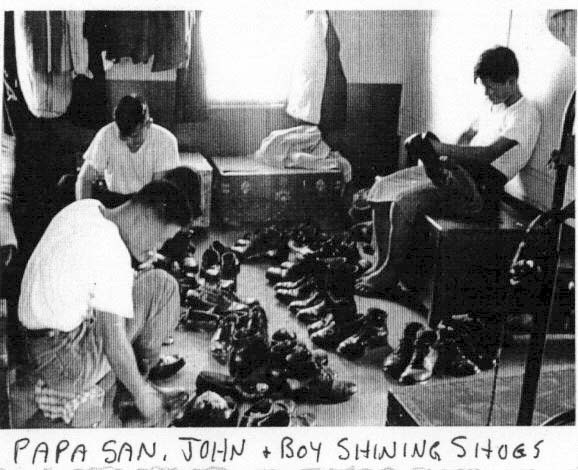
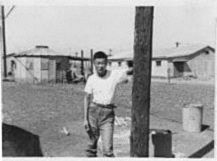
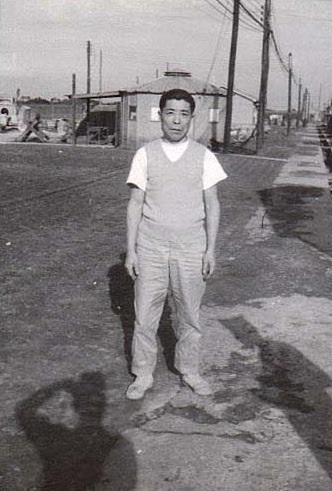
TOP ROW above: (1.) 1956/57 shot of Linkou's corrugated metal, open bay barracks. Round telephone shack in left background. (2.) 1956/57 barracks shot. (L-R) "Bookie", "Willie" Williamson, and Bill. (3.) 1956/57 barracks shot (all unidentified). Stove visible on lower right. (4.) 1956/57 shot of the Linkou showers near the barracks. Sign on the water tank reads: "Potable Water". (5.) Finally hitting water 1956...drilling the deep water well on base was completed in June 1956 (see details below).
BOTTOM ROW above: (1.) 1958 shot of Wally Astor ('57-'59, '62-'64) on a bunk in a crowded open-bay barracks. Mosquito netting is shown suspended above the bunks. (2.) "Central Heating". Barracks space heater 1958. (3.) 1956/57 barracks shot of Dave Columbus (Keene, NH). (4., 5. & 6.) 1957/58 shots of the barracks house boys. "Papasan" is in photo 6.
"...The major problem encountered [at Linkou, 1955-56] was the difficulty in supplying sufficient potable water to meet the needs of the unit [327th CRC, ASA]. It was necessary to haul water by tank trailer from Taipei, a 30-mile round trip over exceedingly bad roads. The water then had to be cooked, utilizing immersion heaters and further treated with iodine. A deep water well was completed in June 1956 which negated the need to haul water although chlorination and purification were still required." (Source: History Office, Headquarters US Army Intelligence and Security Command, courtesy of K. Kovach)
Nike Missiles Deployed to Linkou and Taiwan 1958 to 1959
Carl Paparazo, U.S. Army, Linkou 1958 to 1959
Don Milano, May 1958 to Aug. 1959: "They would not allow us to be captured."
F-104s Deployed to Taoyuan Air Base, Taiwan 1958 and 1959
Frank Cruz, Taoyuan Air Base, 1958 to 1959: "We didn't have an evacuation plan."
"Black Cats" Squadron: Taiwan's U-2 Program Note: Additional details and information about the Black Cat Squadron can be found at the Taipei Air Station blog/website (Click Here).
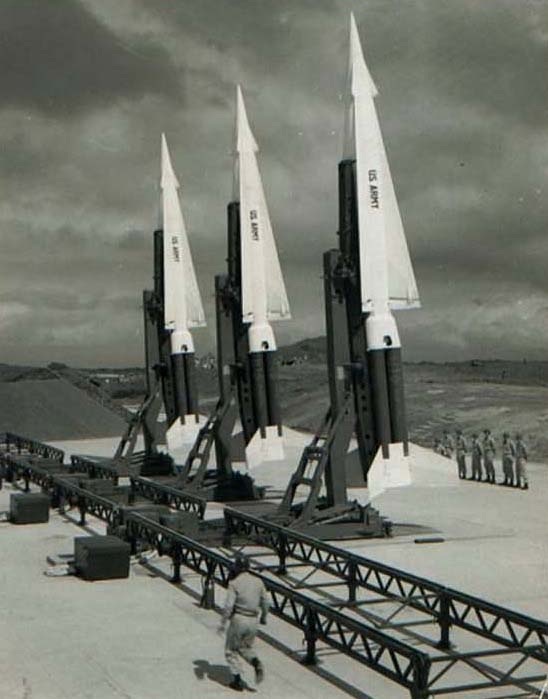
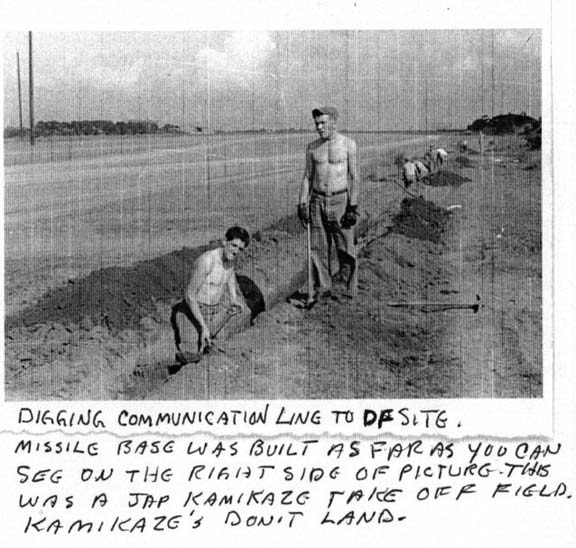 (Left Photo) 1958 shot of a Nike-Hercules launcher section in northern Taiwan. U.S.Army photo
(Left Photo) 1958 shot of a Nike-Hercules launcher section in northern Taiwan. U.S.Army photo
The U.S.Army 2nd Missile Battalion, 71st Artillery (click here for website) deployed from Fort Bliss, Texas in September 1958 to defend Taipei, Taiwan against air attack and invasion during the Taiwan Strait conflict or Quemoy Crisis (click here for website) that commenced on August 23, 1958. On 22 October 1958, D Battery, 2nd Missile Battalion 71st Artillery was operational and providing Northern Taiwan with Nike-Hercules protection against Chicom air threat. The battalion was a fully self-supporting mobile Nike Hercules fighting force with both conventional and nuclear capability in surface-to-air missile (SAM) and surface-to-surface missile (SSM) technology.
As the crisis ground down, the battalion trained Chinese Army counterparts forming the 1st Missile Battalion Chinese Army. Having completed its mission, the 2nd Missile Battalion 71st Artillery was deactivated in August 1959 and went home.
(Right Photo) Shown not far outside the original Main Gate are Airman Kubeck (on right with cap) and others digging a trench next to the old Japanese airstrip (on left) for the communication line between the DF Site (off to the left of the photo) and Operations Center. The 1957/1958 photo was taken several months prior to the October 1958 arrival (after the Aug. 23, 1958 start of the Quemoy Crisis) of the Nike "B & C" missile batteries at Linkou that were located at the end of the Japanese runway (about 600 yards in length) in the distance on the right. photo by Gary Scorby
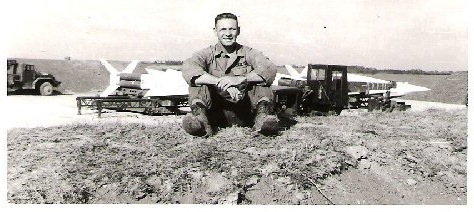
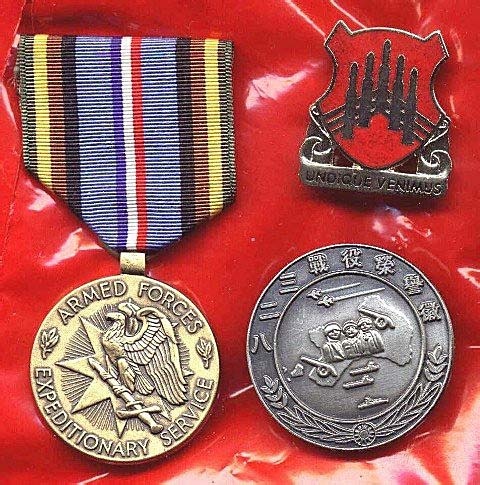 (Left Photo) 1958 shot of SP4 Carl Paparazo, U.S.Army, at the U.S. Nike missile site near Linkou.
(Left Photo) 1958 shot of SP4 Carl Paparazo, U.S.Army, at the U.S. Nike missile site near Linkou.
(Right Image) Carl Paparazo's medals for his Taiwan service during the Quemoy Crisis. images by Carl Paparazo
Carl Paparazo (US Army, Linkou: 1958-59, honorably discharged 1960): "My unit, 2nd Missile Battalion 71st Artillery, was activated in 1958, from Fort Bliss Texas. We had the Nike-Hercules missile, which had SS (surface-to-surface) and SA (surface-to-air) capability. I was in C Battery, located on top of a mountain just a few miles from the USAF Radar and Radio Listening Station at Linkou.
When I got the word to move over to the old 395th (originally the Missile Artillery Unit) I was attending Missile School at Fort Bliss, and within 72 hours I was loading 5-ton trucks with missile hardware for about two weeks...it was a hush-hush, rapid move operation.
We were transported by pullman train to Fort Lewis, Tacoma, Washington and within three days were loaded onto the USS General J. C. Breckinridge (troop transport) for the seven day voyage to Keelung Harbor, Taiwan. Then it was another month of a full-on move effort to load up all our equipment on the ship back onto 5-ton trucks at the harbor and then transport it 35 miles up the mountain to Linkou. I spent nine months there on the mountain top, pulling full-on alerts to our large radar DEW Lines. I enjoyed the people and the country..." [28 July 2011]
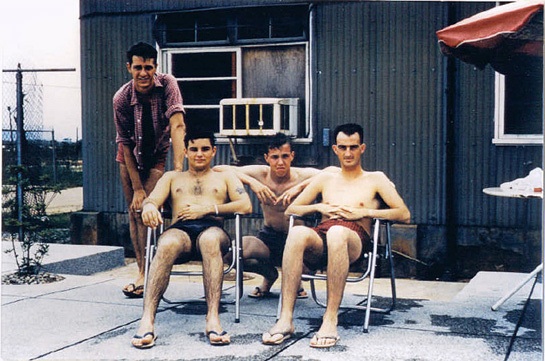 Don Milano (1958-59): "I was stationed at Shu Linkou from late May 1958 to August 1959. You were lucky only to worry about a Chinese invasion. They sent a 1st Lt. to speak with the crypto guys and we were told if the expected invasion came and they couldn't evacuate us in time they would not allow us to be captured. Believe me, we were more worried about being killed by our own guys. One night at the peak of the action, I left work thinking that this would be my last day earth and wondered how our military 'disposed' of its own troops. Needless to say, we prevented the invasion." [27 Dec 2000]
Don Milano (1958-59): "I was stationed at Shu Linkou from late May 1958 to August 1959. You were lucky only to worry about a Chinese invasion. They sent a 1st Lt. to speak with the crypto guys and we were told if the expected invasion came and they couldn't evacuate us in time they would not allow us to be captured. Believe me, we were more worried about being killed by our own guys. One night at the peak of the action, I left work thinking that this would be my last day earth and wondered how our military 'disposed' of its own troops. Needless to say, we prevented the invasion." [27 Dec 2000]
(Right Photo)"The Boys" unwinding at the Linkou pool: (L-R) "Don Milano", Ambeuhl, Al DeConing and Bill Fisher III.
(Left Photo) "The Boys" celebrating in Taipei (L-R) Ambeuhl, Don Milano, John R. Pluta (front), Bill Fisher III and Miller.
photos by Don Milano
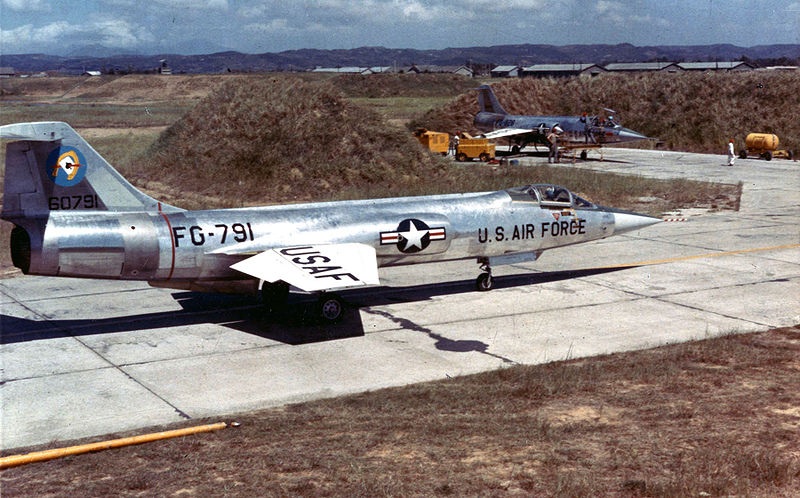
 (Left Photo) USAF Lockheed F-104A Starfighters of the 83rd FIS (Fighter Interceptor Squadron) at Taoyuan Air Base, Taiwan, on Sept. 15, 1958. Twelve F-104s from The 83rd FIS were deployed to Taiwan from Hamilton AFB, Calif. in Sept. 1958 to defend Taiwan during the Quemoy Crisis (Operation" Jonah Able") in 1958 and 1959. In March 1959 all twelve F-104s were transferred back to the U.S. to McClellan AFB, Calif. USAF photo
(Left Photo) USAF Lockheed F-104A Starfighters of the 83rd FIS (Fighter Interceptor Squadron) at Taoyuan Air Base, Taiwan, on Sept. 15, 1958. Twelve F-104s from The 83rd FIS were deployed to Taiwan from Hamilton AFB, Calif. in Sept. 1958 to defend Taiwan during the Quemoy Crisis (Operation" Jonah Able") in 1958 and 1959. In March 1959 all twelve F-104s were transferred back to the U.S. to McClellan AFB, Calif. USAF photo
(Map on Right) Taoyuan is shown on the map on the northwestern tip of Taiwan approximately 15 miles southwest of Taipei and 10 miles south-southwest of Shulinkou AS. photo credit: Taipei Report (1973 edit.)
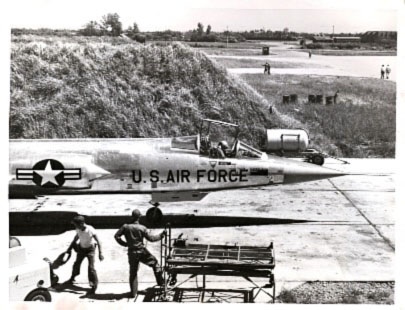 Frank Cruz (Air Police, SLK/Taoyuan AB: 1858-59): "Taoyuan is in northern Taiwan and not far from both Taipei and Shulinkou. I was sent to the USAF air base at Taoyuan from Shulinkou to provide security for a squadron [83rd FIS] of F-104 Starfighters sent there from Hamilton AFB, Calif. in 1958/1959 during the height of the Quemoy/Matsu crisis. The 104's were our answer to the Red Chinese MIG's. During the 1958 and 1959 crisis we were the first and last line of defense in case the Red Chinese invaded Taiwan. I didn't find out until much later that we didn't have an evacuation plan for those stationed at both Shulinkou and Taoyuan Air Base should the Chinese had invaded (...ref. 'Don Milano' above). I guess what you don't know won't hurt you...it's called being young and naive!
Frank Cruz (Air Police, SLK/Taoyuan AB: 1858-59): "Taoyuan is in northern Taiwan and not far from both Taipei and Shulinkou. I was sent to the USAF air base at Taoyuan from Shulinkou to provide security for a squadron [83rd FIS] of F-104 Starfighters sent there from Hamilton AFB, Calif. in 1958/1959 during the height of the Quemoy/Matsu crisis. The 104's were our answer to the Red Chinese MIG's. During the 1958 and 1959 crisis we were the first and last line of defense in case the Red Chinese invaded Taiwan. I didn't find out until much later that we didn't have an evacuation plan for those stationed at both Shulinkou and Taoyuan Air Base should the Chinese had invaded (...ref. 'Don Milano' above). I guess what you don't know won't hurt you...it's called being young and naive!
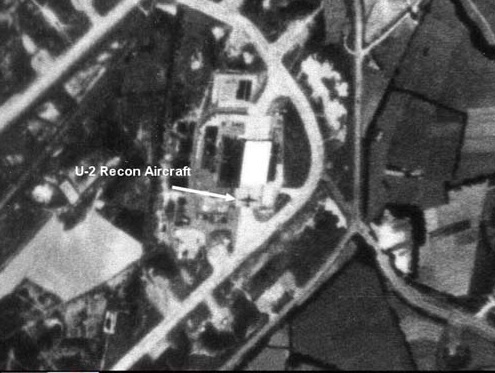 American U-2 planes were sent to Taoyuan Air Base around 1960. The base was ultimately turned over to the Taiwanese after some use during the Viet Nam conflict. It is currently an international airport." [10 July 2007]
American U-2 planes were sent to Taoyuan Air Base around 1960. The base was ultimately turned over to the Taiwanese after some use during the Viet Nam conflict. It is currently an international airport." [10 July 2007]
(Left Photo) 1958 shot of a US F-104 Starfighter (83rd FIS) from Hamiliton AFB, Calif. at Taoyuan USAF Air Base. UPI photo.
(Right Photo) 1968 satellite photo of a US U-2 reconnaissance plane on the tarmac at Taoyuan ROC Air Base. National Archives photo.
Excerpt from an Aug. 25, 2010 "Taipei Times" article, "Cold War Spy Pilots Lift Veil on Secret Missions" (Click Here): "...The U.S. trained ROC Air Force pilots of the elite 35th "Black Cats" Squadron (click here) [from the ROC Taoyuan Air Base] flew the U-2 airplane, dubbed "Dragon Lady", on missions over China's airspace (at altitudes exceeding 20,000 feet) from 1961 until 1974. The U-2 reconnaissance operations were code-named Project Razor.
Of the 28-member Black Cat Squadron, four were shot down and killed over China by surface-to-air missiles, while two others were taken prisoner after being shot down and kept incarcerated for nearly 20 years."